Forums
- Forums
- Axis And Allies Forum
- General Discussion
- Aviation News
Aviation News
Post a reply
- Go to Previous topic
- Go to Next topic
- Go to Welcome
- Go to Introduce Yourself
- Go to General Discussion
- Go to Screenshots, Images and Videos
- Go to Off topic
- Go to Works in Progress
- Go to Skinning Tips / Tutorials
- Go to Skin Requests
- Go to IJAAF Library
- Go to Luftwaffe Library
- Go to RAF Library
- Go to USAAF / USN Library
- Go to Misc Library
- Go to The Ops Room
- Go to Made in Germany
- Go to Campaigns and Missions
- Go to Works in Progress
- Go to Juri's Air-Raid Shelter
- Go to Campaigns and Missions
- Go to Works in Progress
- Go to Skinpacks
- Go to External Projects Discussion
- Go to Books & Resources
-
8 months ago
 Main AdminMembers of the 124th Fighter Wing arrive at Nellis Air Force Base in preparation for Green Flag West, October 25th, 2024. GFW is an extensive joint exercise that emphasizes live-fly operations, providing warfighters with in-depth, air-to-surface integration training. (U.S. Air National Guard photo by Staff Sergeant Joseph R. Morgan)
Main AdminMembers of the 124th Fighter Wing arrive at Nellis Air Force Base in preparation for Green Flag West, October 25th, 2024. GFW is an extensive joint exercise that emphasizes live-fly operations, providing warfighters with in-depth, air-to-surface integration training. (U.S. Air National Guard photo by Staff Sergeant Joseph R. Morgan)
NORTH SEA (Oct. 26 2024) An E/A-18G Growler, attached to the “Main Battery” of Electronic Attack Squadron (VAQ) 144 takes off from the flight deck, aboard the Nimitz-class aircraft carrier USS Harry S. Truman (CVN 75) during the NATO-led maritime vigilance activity Neptune Strike 24-2, Oct. 26, highlighting the strike group’s commitment to supporting NATO operations and collective defense of the Alliance. USS Harry S. Truman, the flagship of the Harry S. Truman Carrier Strike Group (HSTCSG), is on a scheduled deployment in the U.S. 6th Fleet area of operations supporting U.S. Naval Forces Europe-Africa to defend U.S., Allied and partner interests. (U.S. Navy Photo by Mass Communications Specialist 3rd Class Darren Cordoviz)
U.S. Marines assigned to 1st Battalion, 1st Marine Regiment, 1st Marine Division, board an MV-22B Osprey during Final Exercise as part of Weapons and Tactics Instructor course 1-25 at Luke Air Force Base, Arizona, Oct. 26, 2024. WTI is a seven-week training event hosted by Marine Aviation Weapons and Tactics Squadron One which emphasizes operational integration of the six functions of Marine aviation in support of the Marine Air Ground Task Force, Joint and Coalition Forces. (U.S. Marine Corps photo by Cpl. Maurion Moore)
A U.S. Marine Corps KC-130J Super Hercules aircraft with Marine Aerial Refueler Transport Squadron (VMGR) 152, Marine Aircraft Group 12, 1st Marine Aircraft Wing taxis the flight line at Marine Corps Air Station Iwakuni during exercise Keen Sword 25, Oct. 25, 2024. Keen Sword is a biennial, joint and bilateral field-training exercise involving U.S. military and Japan Self-Defense Forces personnel, designed to increase readiness and interoperability while strengthening the ironclad U.S.-Japan alliance. (U.S. Marine Corps photo by Sgt. Jose Angeles)
A U.S. Air Force F-16C Fighting Falcon assigned to the 706th Aggressor Squadron takes off at Nellis Air Force Base, Nevada, Sept. 20, 2024. The U.S. Air Force's Aggressor program provides realistic air combat training for pilots by simulating enemy tactics, techniques, and procedures. (U.S. Air Force photo by Airman 1st Class Brianna Vetro)
A U.S. Air Force F-22 Raptor is refueled by a KC-135 Stratotanker over the U.S. Central Command area of responsibility, Oct. 10, 2024. The F-22 is an advanced capability that enhances missions supporting stability and security within the region.
(Photo by Staff Sgt. William Rosado)
SANTIAGO, Chile, Oct. 28, 2024 /PRNewswire/ -- Boeing [NYSE: BA] and LATAM Airlines Group, the leading passenger and cargo airline group in South America, today announced the purchase of 10 787 Dreamliners with options for five more airplanes. As the region's largest 787 operator, this latest order for fuel-efficient 787-9 jets increases LATAM's investment in one of the most modern fleets in Latin America.
LATAM currently operates 37 787-8s and 787-9s and, including this latest order, expects to grow the fleet to 52 Dreamliners by 2030. The 787 enables the airline to maximize capacity on popular routes and launch new routes including its nonstop flight to Sydney, Australia.
"The Boeing 787 is a much more efficient aircraft, allowing us to continue growing sustainably while reducing our carbon footprint as we drive the growth of our operations. This order will enable us to receive at least two aircraft of this model each year from 2025 until the end of the decade," said Ramiro Alfonsín, Chief Financial Officer of the LATAM Airlines Group.
The 787 family offers unmatched fuel efficiency, enabling airlines to reduce fuel use and emissions by 25% compared to the airplanes they replace. The larger 787-9 extends the capacity and range of the Dreamliner family, flying more passengers and cargo farther.
"We appreciate LATAM's continued confidence in the 787 Dreamliner family to further expand its international network from hubs in Santiago, Sao Paulo and Lima," said Mike Wilson, Boeing vice president of Commercial Sales for Latin America and the Caribbean. "As demand for air travel rises, we will continue to support LATAM's growth strategy and goal of connecting Latin America with the world."
Since entering service in 2011, 787 Dreamliners have helped operators launch more than 400 new nonstop routes and avoid more than 173 billion pounds of carbon emissions.
The 2024 Boeing Commercial Market Outlook forecasts air travel in Latin America will more than double over the next 20 years, growing 5% annually. With nearly 2,300 airplane deliveries expected, the region's fleet is projected to grow to more than 3,000 airplanes by 2043.
As a leading global aerospace company, Boeing develops, manufactures and services commercial airplanes, defense products and space systems for customers in more than 150 countries. As a top U.S. exporter, the company leverages the talents of a global supplier base to advance economic opportunity, sustainability and community impact. Boeing's diverse team is committed to innovating for the future, leading with sustainability, and cultivating a culture based on the company's core values of safety, quality and integrity. Join our team and find your purpose at boeing.com/careers.
809 NAS and 617 Squadron working together during a night flying exercise on #StrikeWarrior.
(Photo courtesy of the RN)
Some shots from Exercise Black Dagger 24! in Australia.
Between 07 and 18 October, #AusAirForce deployed personnel and aircraft to RAAF Base Townsville to conduct Ex Black Dagger 24.
This was the final activity for the No. 75 Joint Terminal Attack Controller (JTAC) Course, run by No. 4 Squadron out of RAAF Base Williamtown where students coordinated the live and simulated employment of aircraft and ordnance in air-to-ground scenarios.
No. 4 Squadron was joined in Townsville by No. 1 Squadron, and the Australian Army 1st Battalion Royal Australian Regiment.
(Photos courtesy of the RAAF)
The Koninklijke Luchtmacht and its F-35A's have been expanding there night time flying.


Because of the short dark days, the coming months are very suitable for that. The aircraft fly from Monday to Thursday until no later than 22:30.
(Photos courtesy of the Koninklijke Luchtmacht ) -
8 months ago
 Main AdminU.S. Air Force Maj. Taylor “FEMA” Hiester, F-16 Viper Demonstration Team commander and pilot, left, and Retired Lt. Col. Charles “Tuna” Hainline, Air Force Heritage Flight Foundation P-51 Mustang pilot, fly in formation during the Wings Over Houston airshow at Ellington Airport, Oct. 27, 2024. The Air Combat Command demonstration teams works closely with the Air Force Heritage Flight Foundation to create a unique demonstration for the U.S. Air Force past and present, exhibiting the professional qualities the Air Force develops in the people who fly, maintain, and support these aircraft. (U.S. Air Force photos by Senior Airman Meghan Hutton)
Main AdminU.S. Air Force Maj. Taylor “FEMA” Hiester, F-16 Viper Demonstration Team commander and pilot, left, and Retired Lt. Col. Charles “Tuna” Hainline, Air Force Heritage Flight Foundation P-51 Mustang pilot, fly in formation during the Wings Over Houston airshow at Ellington Airport, Oct. 27, 2024. The Air Combat Command demonstration teams works closely with the Air Force Heritage Flight Foundation to create a unique demonstration for the U.S. Air Force past and present, exhibiting the professional qualities the Air Force develops in the people who fly, maintain, and support these aircraft. (U.S. Air Force photos by Senior Airman Meghan Hutton)

Two U.S. Air Force F-35A Lightning II aircraft, with the F-35 Demonstration Team, approach a U.S. Air Force KC-135 for in-flight refueling en route to their next airshow at Pensacola, Florida, on 28 October, 2024. The F-35 Demo Team travels to various bases to showcase the capabilities of the most advanced 5th generation fighter aircraft. (U.S. Air Force photo by Senior Airman Nicholas Rupiper)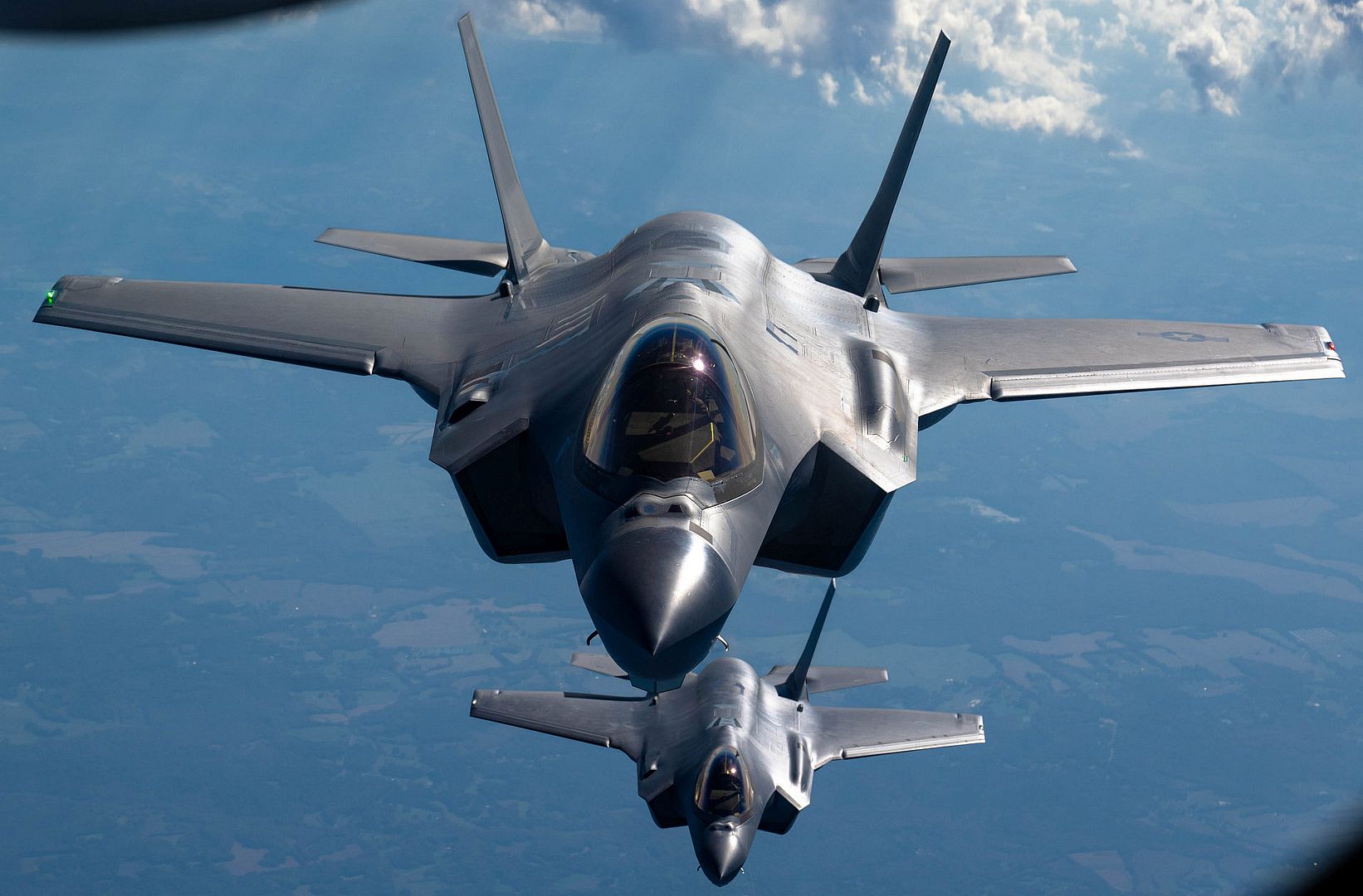
Air Force Two arrives at Selfridge Air National Guard Base, Michigan, Oct. 28, 2024. Vice President Kamala Harris briefly visited SANGB during a visit to southeast Michigan. (U.S. Air Force Photo by 2nd Lt. Elise Wahlstrom)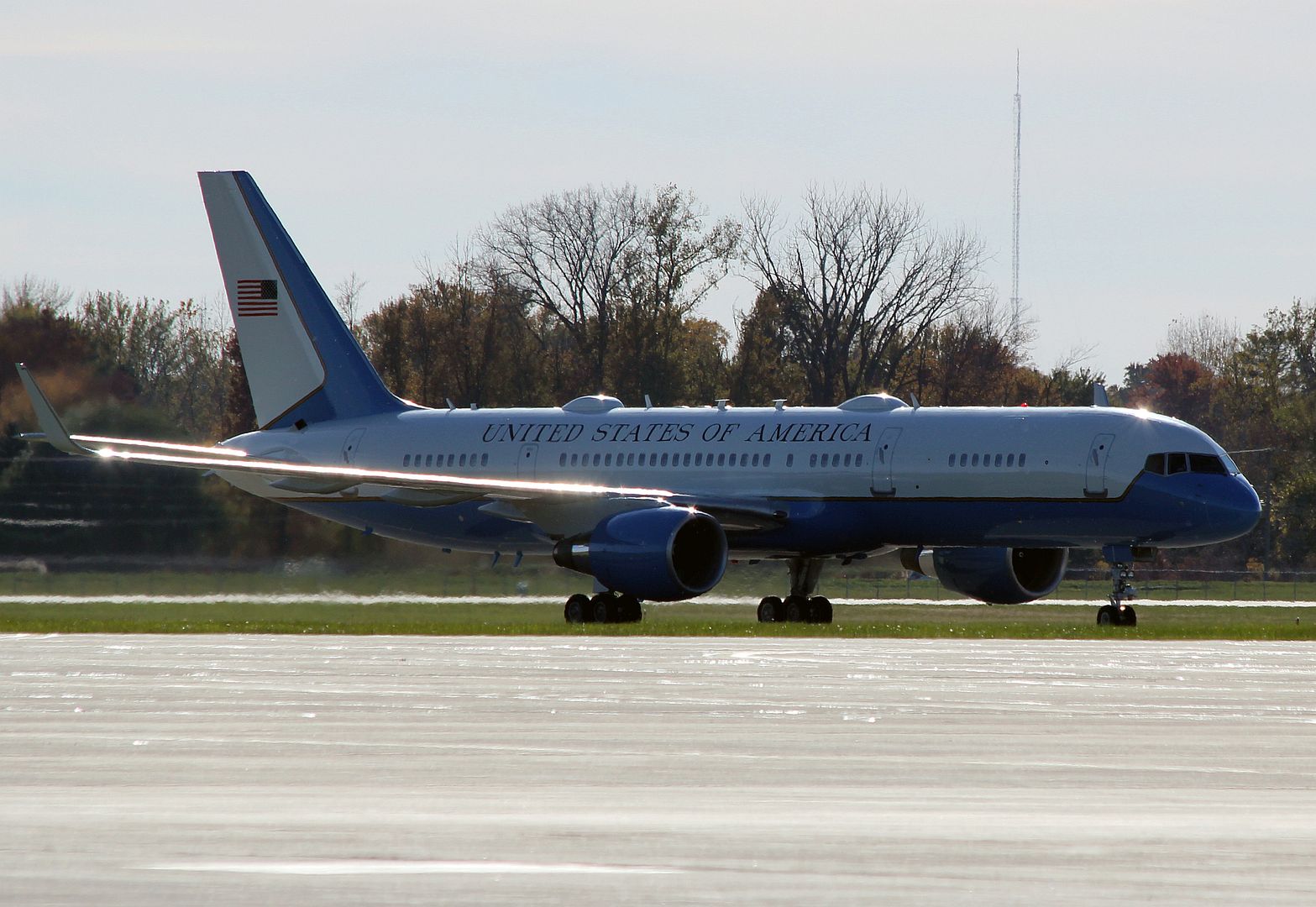
A B-52H Stratofortress assigned to the 2nd Bomb Wing prepares for take off in preparation for Global Thunder 25 at Chennault International Airport at Lake Charles, La., Oct. 24, 2024. The ability to land and operate from Chennault International Airport is a vital component of the training carried out in Global Thunder 25, demonstrating our preparedness to execute our mission under any conditions. (U.S. Air Force photo by Airman 1st Class Aaron Hill)
An F-16 Fighting Falcon assigned to the 85th Test and Evaluation Squadron taxies after flying with the Integrated Viper Electronic Warfare Suite (IVEWS) for the first time at Eglin Air Force Base, Florida, last month. IVEWS is a self-protecting electronic warfare system on the F-16 that provides digital radar warnings and active jamming capability to detect, identify, locate and counter potential threats. (U.S. Air Force photos by 1st Lt. Rebecca Abordo)
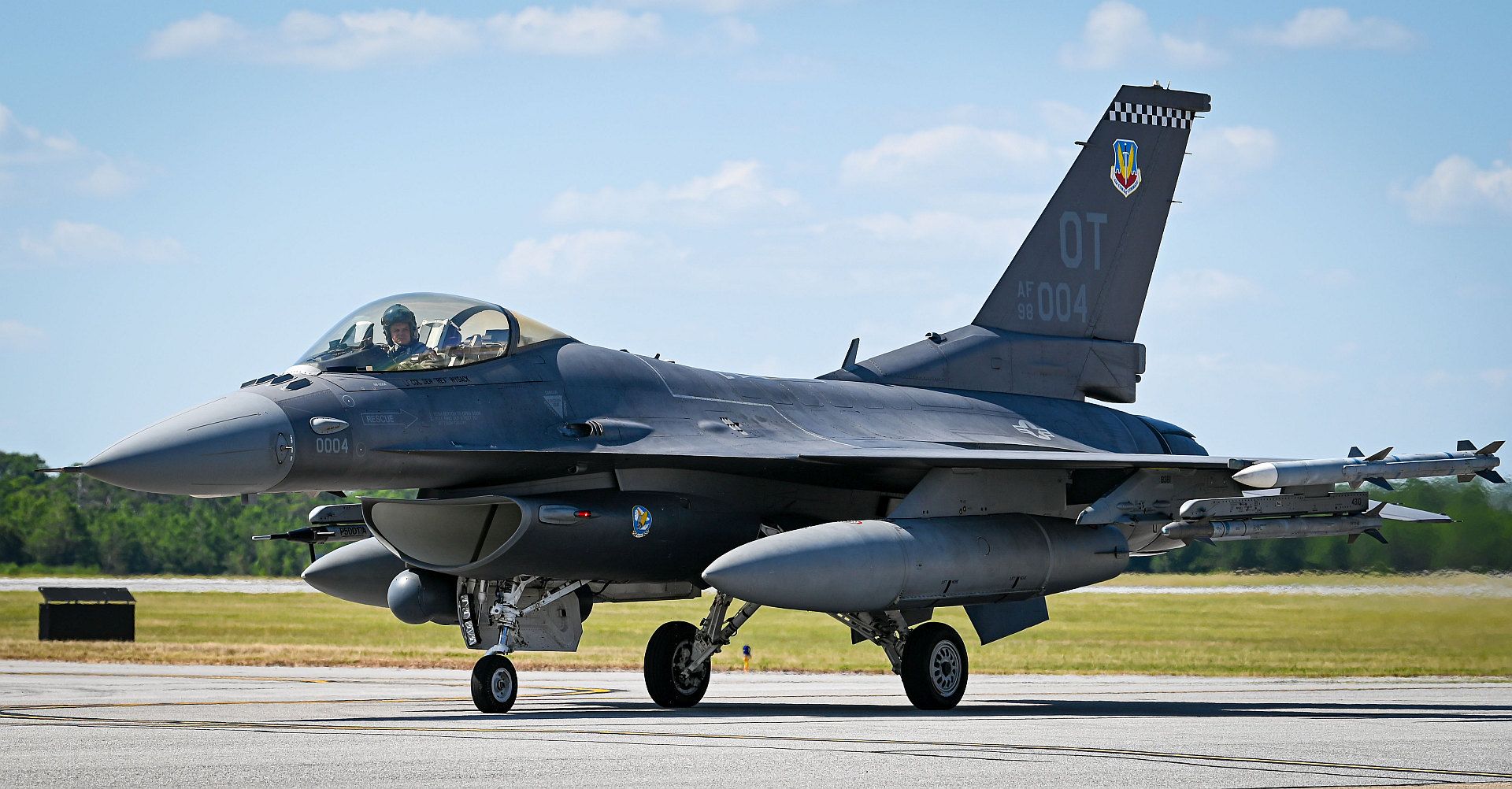
U.S. Air Force T-38C Talon is showcased during a Combat Women in Aviation event at Sheppard Air Force Base, Texas, Oct. 25, 2024. This event marked the first Combat Women in Aviation fly-in hosted by the Euro-NATO Joint Jet Pilot Training program to showcase various aviation careers and the importance of diversity in maintaining the U.S. Air Force’s competitive edge. (U.S. Air Force photo by Senior Airman Katie McKee)
A U.S. Navy F/A-18E Hornet prepares to receive fuel from a U.S. Air Force KC-135 Stratotanker over the U.S. Central Command area of responsibility, Oct. 15, 2024. The F/A-18E is deployed to the U.S. 5th Fleet area of operations to help ensure maritime security and stability In the Middle East region. (Photo by Senior Airman Zachary Willis)
A U.S. Navy F/A-18F Hornet receives fuel from a U.S. Air Force KC-135 Stratotanker over the U.S. Central Command area of responsibility, Oct. 15, 2024. The F/A-18F is deployed to the U.S. 5th Fleet area of operations to help ensure maritime security and stability In the Middle East region. (Photo by Senior Airman Zachary Willis)
A Carrier Air Wing (CVW1) F/A-18E Super Hornet and a U.S. Air Force KC-135 refuel over Sweden during the NATO-led maritime vigilance activity Neptune Strike 24-2, Oct. 24, 2024, highlighting the strike group's commitment to supporting NATO operations and collective defense of the alliance. USS Harry S. Truman, the flagship of the Harry S. Truman Carrier Strike Group (HSTCSG), is on a scheduled deployment in the U.S. 6th Fleet area of operations supporting U.S. Naval Forces Europe-Africa to defend U.S., allied and partner interests. (U.S. Navy courtesy photo by Lt. Lily Moorhead)
STRATFORD, Conn., Oct. 29, 2024 –The U.S. Government has awarded Sikorsky, a Lockheed Martin company (NYSE: LMT), a Foreign Military Sale contract to provide 35 UH-60M Black Hawk helicopters to Greece. The deal includes 35 aircraft for the Hellenic Army as well as personnel training, training equipment and an initial provisioning package, which will significantly improve self-defense and bolster interoperability within the nation and with NATO allies.
“Our partnership with Greece spans decades, and we are pleased to see the nation’s continued trust in Sikorsky helicopters as Greece will benefit from an integrated Hawk family of aircraft supporting national security and humanitarian missions,” said Hamid Salim, Sikorsky vice president of Army and Air Force Systems. “The Black Hawk helicopter offers Greece a range of operational capabilities and a global ecosystem of more than 5,000 Hawk aircraft operated by 36 countries around the world.
“The newly contracted UH-60M Black Hawk helicopters are an additional testament for the long-standing relationship Lockheed Martin shares with Greece, its Armed Forces and defense industries for over 80 years,” said Costas Papadopoulos, international business development executive director for Greece at Lockheed Martin. “The Black Hawk helicopter is the workhorse of multi-mission medium lift aircraft and will enable Greece to perform key operations in the region. These helicopters will join Greece's upgraded F-16Vs, new MH-60Rs, existing F-16s, C-130s, and S-70Bs, as well as future F-35s. This enhanced fleet will provide Greece with extended capabilities for air, land, and sea operations, contributing to the nation's security for years to come.”
With its existing S-70B fleet and newly acquired MH-60R maritime helicopters for the Hellenic Navy, Greece will operate several variants of the Hawk family and benefit from the operational and sustainment advantages of fleet commonality. The Black Hawk has flexibility to conduct a variety of operations at greater ranges and in the most challenging environments, increasing survivability and overall effectiveness for 21st Century Security® missions.
Building on Lockheed Martin’s partnership with Greece of more than 80 years, the company stands ready to support Greece and deliver capabilities such as F-35s, F-16s and C-130s, in addition to Hawk aircraft that will increase the country’s deterrent capabilities and interoperability with allied nations.
Greece will be the 12th European country to operate the Black Hawk helicopter. In 2024, the U.S. Government has awarded Sikorsky contracts to manufacture and deliver a total of 84 UH-60M Black Hawk helicopters to countries in Europe, Asia, the Middle East and South America, further proving the Black Hawk is the premier multi-role utility helicopter around the globe. On Oct. 23, Sikorsky also received UH-60M contract awards to grow the Black Hawk fleets in Austria, Brazil, Sweden and Thailand. In July, Sikorsky received contracts for Black Hawks in Croatia and Jordan; in June, Romania also added to its fleet of S-70 Black Hawks, which share the same pedigree as the UH-60M.
Vero Beach, FL., October 29, 2024 – Piper Aircraft announces today that the M700 FURY has received type certification from the European Union Aviation Safety Agency (EASA), Brazil’s Agência Nacional de Aviação Civil (ANAC), and the Civil Aviation Safety Authority (CASA) of Australia, including approval for flight into known icing (FIKI) and unpaved surfaces. Customers in these regions have been eagerly awaiting these certifications to take delivery of their aircraft, with deliveries beginning this month.
The M700 FURY is the fastest single-engine aircraft in Piper’s history, offering a maximum cruise speed of 301 knots and a range of 1,424 nautical miles. Powered by a Pratt & Whitney PT6A-52 engine, this cabin-class turboprop combines exceptional performance with advanced features; including the HALO Safety System with Garmin’s Emergency Autoland, and FIKI making it ideal for both private owners and operators.
“The EASA, ANAC, and CASA certifications are significant milestones for the M700 FURY,” said John Calcagno, President & CEO of Piper Aircraft. “These approvals reinforce our commitment to delivering a world-class aircraft with exceptional performance, safety, and versatility to key international markets.”
The M700 FURY is designed with both safety and ease of use in mind. Safety-enhancing features include Garmin’s Electronic Stability Protection (ESP), SurfaceWatch™, and SafeTaxi®, providing pilots with increased awareness and control. For ease of use, the aircraft is equipped with Autothrottle and Garmin PlaneSync™, simplifying operations and streamlining preflight and in-flight procedures.
About Piper Aircraft
Piper Aircraft Inc., headquartered in Vero Beach, Fl., offers aviators throughout the world efficient and reliable single and twin-engine aircraft and is the first general aviation aircraft manufacturer in the world to certify Garmin® Emergency Autoland. The single-engine M-Class series – the M700 FURY, M500, and M350 – offers businesses and individuals elegant performance, value and a superior ownership experience. The Personal Class Archer LX and Archer DLX balance proven performance, efficiency, and simplicity in a piston-powered aircraft. The Trainer Class Pilot 100i, Archer TX, Archer DX, and Seminole aircraft form the most complete technically advanced line of pilot training aircraft in the world. Piper is a member of the General Aviation Manufacturers Association. To learn more about Piper Aircraft, visit the company’s website at www.piper.com.
About the Piper M700 FURY
The Piper M700 FURY was certified in March of 2024 and comes standard with the HALO Safety System, featuring Garmin Emergency Autoland. This revolutionary system includes digital technology that safely lands the aircraft at the nearest suitable airport in the event that the pilot is incapacitated. Additionally, the M700 FURY G3000® avionics suite includes; Autothrottle, Emergency Descent Mode, Electronic Stability Protection (ESP™), SurfaceWatch™, SafeTaxi®, and Garmin PlaneSync™, all of which are designed to enhance safe operation of the aircraft. Beyond the flight deck, the six-seat M700 FURY is powered by a Pratt & Whitney PT6A-52 700 SHP engine. The aircraft has a maximum cruise speed of 301ktas/557 km/hr, a max range of 1,852 nm/3,430 km, and a standard useful load of 2,320 lbs/1,052 kg.
Media Release 29.10.2024
The Pilatus PC-12 Was Last Year’s Most Flown Business Aircraft in the USA
The Swiss-Made PC-12 was last year’s most frequently flown business aircraft in the USA. Specifically, 316,328 takeoffs by the “World’s Greatest Single” were recorded between August 2023 and July 2024, representing 8.8 percent of all departures. Once again, this single-engine turboprop impresses with its versatility, safety, reliability and efficiency.
In business aviation, the USA is the world’s dominant market. “AvBuyer” provides an overview of the most frequently flown business aircraft based on information from “WingX Advance”, the aviation industry data specialist. This overview reveals that the Pilatus PC-12 comes top of the list of most frequently flown business aircraft in the USA – with 316,328 takeoffs between August 2023 and July 2024.
Market leader with a proven engine
Statistically, a good 70 of the world’s global fleet of over 2,000 PC-12s are in the air at any given time. In 2023 alone, Pilatus produced 101 PC-12s in the heart of Switzerland for delivery all over the world, including 48 for customers in the USA. The international PC-12 fleet has now completed well over ten million hours in the air and is used for a wide range of missions – including business travel, cargo transport, air ambulance and emergency services.
Launched in 2019, the latest version, the PC-12 NGX, is a state-of-the-art aircraft fitted with the safest turboprop engine available – the Pratt & Whitney Canada PT6. Stastics show that this engine makes the PC-12 is one of the safest single-engine aircraft around.
The PC-12 embodies Pilatus’s efforts in the area of sustainability and is capable of reaching destinations with comparatively low fuel consumption. The engine is certified for Sustainable Aviation Fuel (SAF), another benefit which contributes to safe, efficient flight.
HMS Prince of Wales bade farewell to the jets of 809 Naval Air Squadron after their maiden embarkation at sea ended yesterday.
The F-35B Lightnings spent one month aboard the Portsmouth-based warship, building up from the fundamental ability to land on/take off from her flight deck by day and night through to strike missions, dropping live Paveway bombs on the range at Cape Wrath – the northwesternmost tip of the Scottish mainland.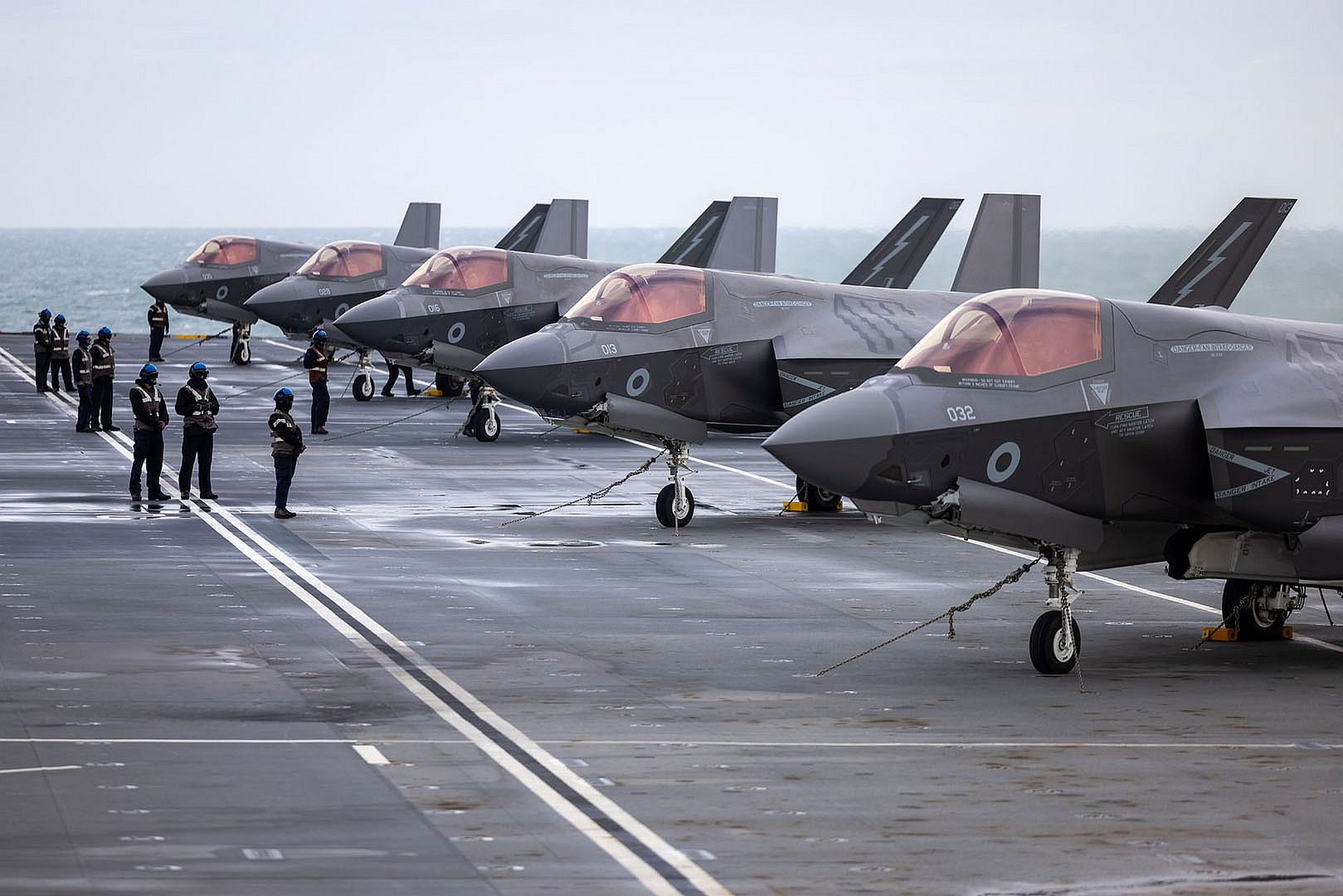
The Lightnings – flown, as with all UK F-35s, by a combination of Navy and RAF pilots – performed diamond-formation flypasts of the carrier before making a beeline for their home air base in Norfolk, RAF Marham.
Commander Nick Smith, 809 Naval Air Squadron’s Commanding Officer, said the maiden embarkation had been “phenomenally successful”, laying “firm foundations” for when his F-35s re-join the task group in 2025 on its first deployment.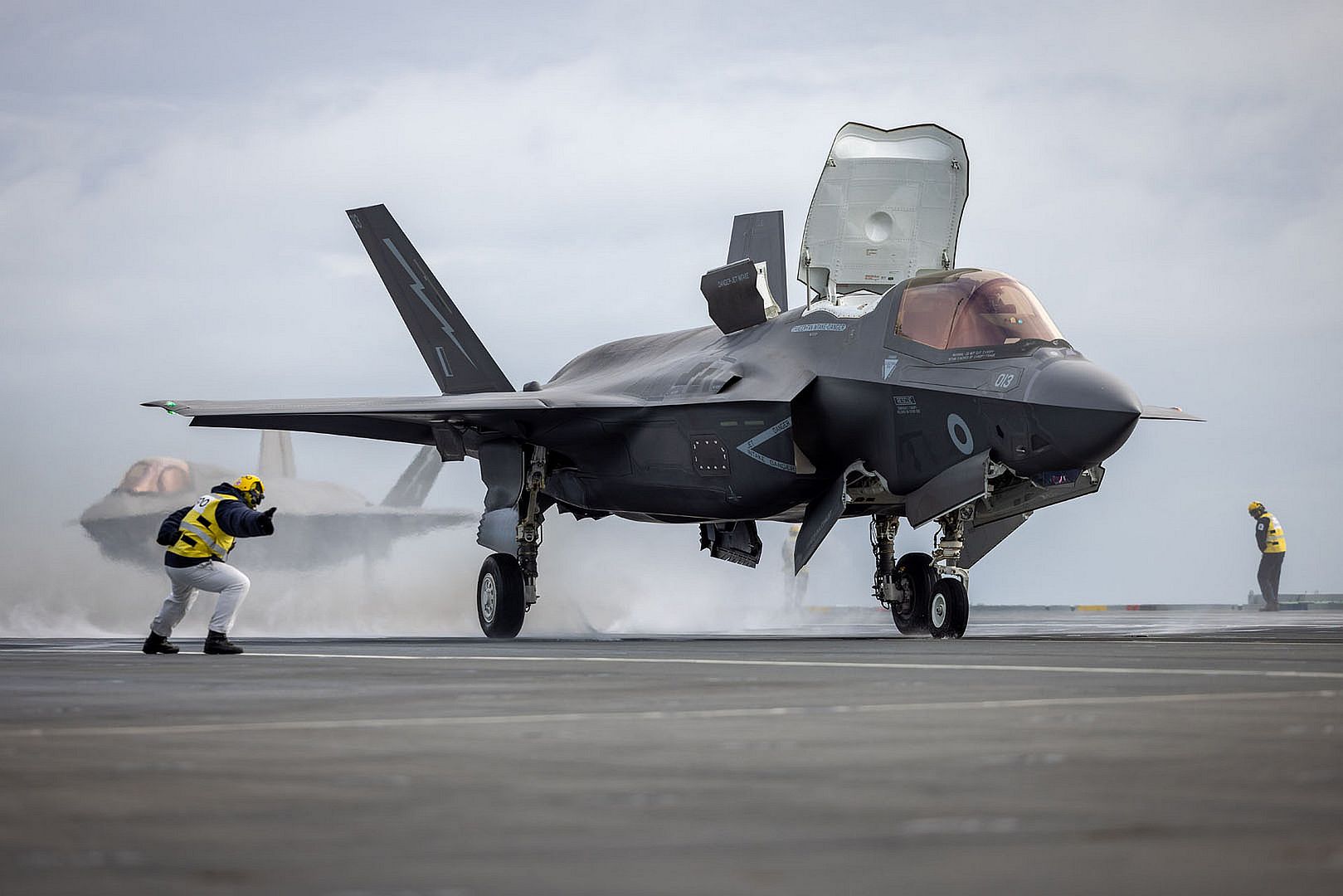
He continued: “The training teams have surpassed their targets with 19 pilots completing carrier qualifications within the first weeks of the deployment and flight deck teams receiving their authorisations to safely operate on the deck, both day and night.
“Our integration has also spread beyond the ship, demonstrated by the successful release of live weapons on targets at Cape Wrath; weapons prepared by the ship’s company, loaded and delivered by 809 NAS and 617 Squadron engineers and pilots, controlled by Royal Marine Commandos on the ground.”
HMS Prince of Wales is due to return to Portsmouth tomorrow.
(Photos courtesy of the RN)
The RSAF’s Fighter Detachment in Royal Australian Air Force (RAAF) Base Pearce has come to a close! The Fighter Detachment took place from 25 Jun to 18 Oct 24, and involved the F-16 and F-15SG fighter jets across three frames.
The Fighter Detachment has provided valuable and realistic training opportunities for RSAF air and ground crew.
(Photos courtesy of the RAAF)
-
8 months ago
 Main AdminA U.S. Army UH-60 Black Hawk helicopter assigned to 2nd Assault Helicopter Battalion, 10th Combat Aviation Brigade, conducts low-level flight operations in Northeast Syria, Oct. 29, 2024. Large-scale, multi-capability exercises like these enhance the readiness of Coalition Forces to employ a variety of tactics and capabilities to defeat ISIS at any time, in any place, across the region. (U.S. Army photo by Capt. Daniel Andrews)
Main AdminA U.S. Army UH-60 Black Hawk helicopter assigned to 2nd Assault Helicopter Battalion, 10th Combat Aviation Brigade, conducts low-level flight operations in Northeast Syria, Oct. 29, 2024. Large-scale, multi-capability exercises like these enhance the readiness of Coalition Forces to employ a variety of tactics and capabilities to defeat ISIS at any time, in any place, across the region. (U.S. Army photo by Capt. Daniel Andrews)
NORTH SEA (Oct. 28, 2024) An E/A-18G Growler, attached to the “Main Battery” of Electronic Attack Squadron (VAQ) 144, takes off from the flight deck of the Nimitz-class aircraft carrier USS Harry S. Truman during the NATO-led maritime vigilance activity Neptune Strike 24-2, Oct. 28, highlighting the strike group’s commitment to supporting NATO operations and collective defense of the Alliance. USS Harry S. Truman, the flagship of the Harry S. Truman Carrier Strike Group (HSTCSG), is on a scheduled deployment in the U.S. 6th Fleet area of operations supporting U.S. Naval Forces Europe-Africa to defend U.S., Allied and partner interests. (U.S. Navy photo by Mass Communication Specialist 3rd Class Logan Nystrand)
MEDITERRANEAN SEA (Oct. 28, 2024) Sailors assigned to the amphibious assault ship USS Wasp (LHD 1) and Marines assigned assigned to Marine Medium Tiltrotor Squadron (VMM) 365 (Reinforced) refuel an AV-8B Harrier jet assigned to VMM 365 (Reinforced) on the ship’s flight deck to support a long-range maritime strike event as part of Neptune Strike 2024-2 (NEST 24-2), Oct. 28, 2024. Wasp is supporting NEST 24-2 while on a scheduled deployment to the U.S. Naval Forces Europe and Africa (NAVEUR-NAVAF) area of operations as the flagship of the Wasp Amphibious Ready Group (WSP ARG)-24th Marine Expeditionary Unit (MEU) Special Operations Capable (SOC) in support of U.S., Allied, and partner interests in the region, including in the Eastern Mediterranean Sea, to continue promoting regional stability and deterring aggression. (U.S. Navy photo by Mass Communication Specialist 3rd Class Keresea Illenye)
A T-38 Talon is parked on the east flightline prior to a 435th Fighter Training Squadron group October 21, 2024, at Joint Base San Antonio-Randolph, Texas. The T-38 Talon is a twin-engine, high-altitude, supersonic jet trainer used in a variety of roles because of its design, economy of operations, ease of maintenance, high performance and exceptional safety record. Air Education and Training Command is the primary user of the T-38 for joint specialized undergraduate pilot training. Air Combat Command, Air Force Materiel Command and the National Aeronautics and Space Administration also use the T-38A in various roles. (U.S. Air Force photo by Sean Worrell)
The U.S. Air Force KC-135 Stratotanker known as “Sly Fox,” assigned to the 100th Air Refueling Wing, sits on the flight line before a night air refueling familiarization at Royal Air Force Mildenhall, England, Oct. 22, 2024. The KC-135 provides essential aerial refueling support, which extends the range and endurance of U.S. and allied aircraft. This capability is particularly important in Europe and surrounding areas, where air operations may require long flights across multiple countries and geographic regions. (U.S. Air Force photo by Senior Airman Katie Mullikin)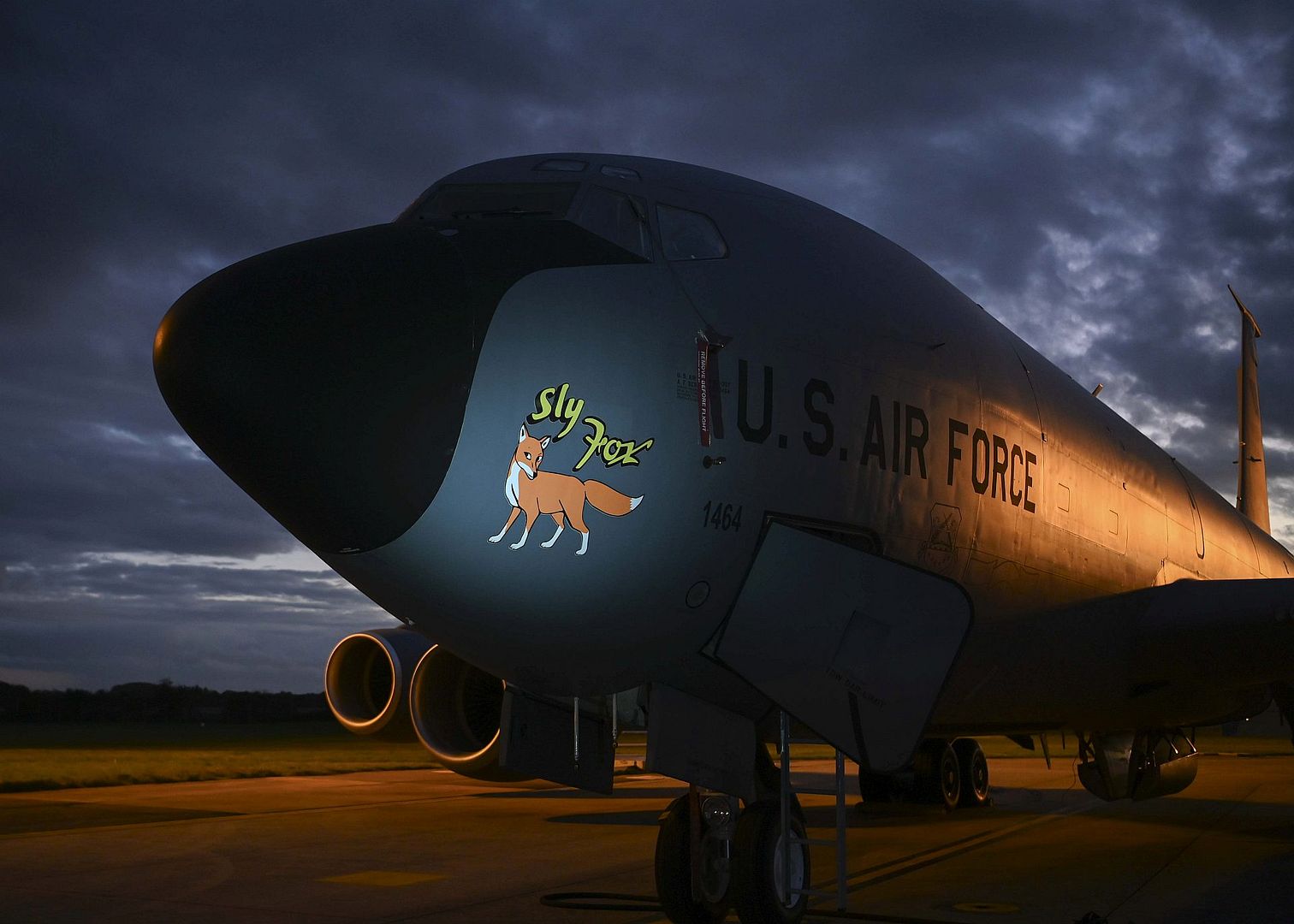
Dirk Pilzecker, German Luftwaffe F-2000 Eurofighter Typhoon aircraft maintainer, checks the side of a F-16 Fighting Falcon fighter jet during a cross servicing training at Spangdahlem Air Base, Germany, Oct. 17, 2024. The training refreshed on the necessary safety equipment and routine inspections required to land and perform the proper procedures of the F-16. This training is a crucial step in United Air Force - Europe and Africa and NATO’s plan to implement this cross servicing capability Europe wide, strengthening the bond with our partner nations. (U.S. Air Force photo by Airman 1st Class Sydney Franklin)
U.S. Air Force 100th Air Refueling Wing Forward Area Refueling Point (FARP) Airmen and 352d Special Operations Wing loadmasters refuel a British Army AH-64E Apache from the 3 Regiment Army Air Corps, by an MC-130J Commando II with the 352 SOW, United Kingdom, Oct. 24, 2024. FARP enables the refueling of other aircraft in austere locations where traditional refueling is not possible. In this instance, the training increased the interoperability between allied nation forces. (U.S. Air Force photo by Tech. Sgt. Westin Warburton)
Two U.S. Air Force F-22 Raptors fly in formation over the U.S. Central Command area of responsibility, Oct. 10, 2024. The deployment of the fifth-generation aircraft into the theater demonstrates the United States’ dedication to deterring aggression and maintaining stability in the region. (Photo by Staff Sgt. Gerald Willis)
A U.S. Air Force AC-130J Ghostrider prepares to receive fuel over the U.S. Central Command area of responsibility Oct. 13, 2024. The AC-130J Ghostrider's primary missions are close air support, air interdiction and armed reconnaissance.
(Photo by Senior Airman Zachary Willis)
A U.S. Air Force F-15E Strike Eagle receives fuel over the U.S. Central Command area of responsibility Oct. 13, 2024. The F-15E is an all-weather, extremely maneuverable, tactical fighter designed to allow the Air Force to gain and maintain air supremacy over the CENTCOM area of responsibility and provides security to ground forces conducting counter-violent extremist operations. (Photo by Senior Airman Zachary Willis)
A U.S. Air Force 13th Fighter Squadron F-16 Fighting Falcon taxis on the flightline, during Exercise Beverly Sunrise 24-6 at Misawa Air Base, Japan, Oct. 24, 2024. The 13th FS supported the Beverly Sunrise 24-6 exercise, demonstrating agile combat employment throughout the Indo-Pacific region, ensuring air superiority and deterring potential threats to allied forces. (U.S. Air Force photo by Airman 1st Class Andre Medina)
A U.S. Air Force 13th Fighter Squadron F-16 Fighting Falcon flies during the Beverly Sunrise 24-6 exercise at Misawa Air Base, Japan, Oct. 24, 2024. The 35th Fighter Wing conducts regular exercises to enhance combat readiness vital to protecting U.S. and allied assets throughout the U.S. Indo-Pacific region. (U.S. Air Force photo by Airman 1st Class Andre Medina)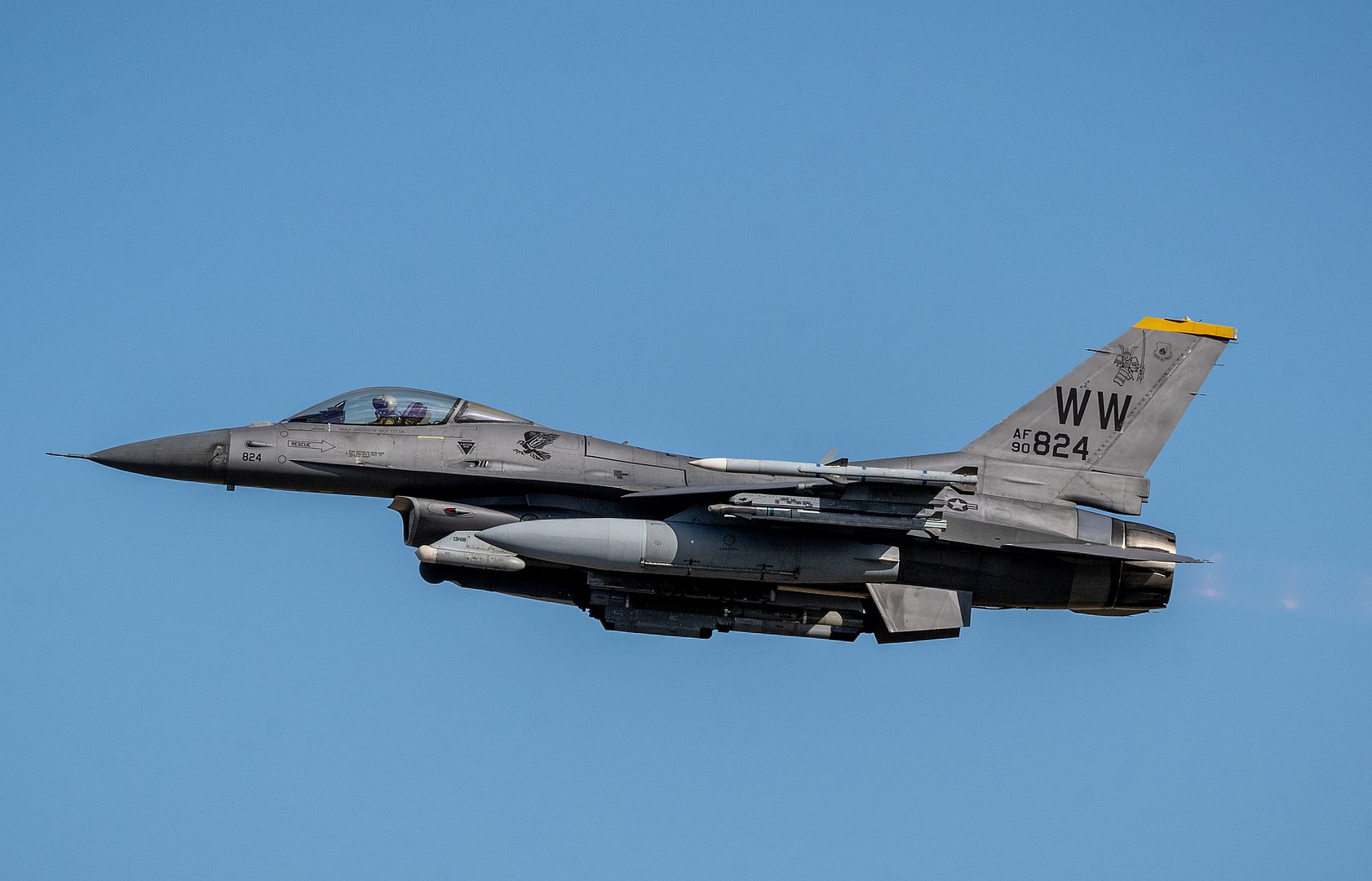
Orlando, Fla., Oct. 30, 2024 – Lockheed Martin (NYSE: LMT) will deliver Sniper Advanced Targeting Pods (ATP) to Poland in a sale the U.S. State Department said will improve the security of a NATO ally that is a “force for political stability.”
The targeting systems for Poland were included in a recently finalized U.S. Foreign Military Sale contract worth $90.68 million to Lockheed Martin. Poland will receive Sniper Advanced Targeting Pods with two-way datalinks, system support and spare parts.
The targeting-sensor system will be integrated onto Poland’s new FA-50 fighter jets. Lockheed Martin already equips Polish F-16s with Sniper ATPs.
Integration of Sniper ATP will improve the tactical effectiveness of Poland’s FA-50s by enhancing their ability to identify, track, and engage targets from standoff distances.
Sniper ATP also will increase interoperability with U.S. and NATO forces, the U.S. State Department said upon approving the sale in 2023.
Sniper ATP provides pilots with unmatched imagery for precision targeting and non-traditional intelligence, surveillance and reconnaissance.
In the future, the Sniper pods for Poland’s FA-50 and F-16 fighters could be quickly upgraded to a new variant, the Sniper Networked Targeting Pod, which was announced by Lockheed Martin in July. When enhanced with advanced datalink and radio technology, Sniper pods will enable unprecedented interoperability for 4th Generation aircraft, new F-35 Lightning II fighters, and ground-based artillery systems such as HIMARS.
Lockheed Martin’s ongoing innovation with Sniper is part of the company’s vision for 21st Century Security®, which is integrating networking capabilities and edge computing across customers’ aircraft, sensor systems and weapons.
About Lockheed Martin
Lockheed Martin is a global defense technology company driving innovation and advancing scientific discovery. Our all-domain mission solutions and 21st Century Security® vision accelerate the delivery of transformative technologies to ensure those we serve always stay ahead of ready. More information at Lockheedmartin.com.
Hamburg, Germany, 30 October 2024 – Spanish flag carrier Iberia has taken delivery of its first A321XLR, becoming the launch operator of the world’s newest single-aisle aircraft.
The aircraft, powered by CFM LEAP-1A engines, will be operated by Iberia on a number of regional flights across the airline’s European network before its first transatlantic mission from Madrid to Boston later in November.
Marco Sansavini, CEO & Chairman at Iberia, said: “We are very proud to be the launch airline for this new Airbus aircraft. The A321XLR will allow us to reach new destinations, operating transoceanic routes and doing so in a more efficient way.”
Christian Scherer, CEO Commercial Aircraft at Airbus, said: “Five years in the making, the newest member of the Airbus family is all set to join its first operator, Iberia. The A321XLR will enable countless new non-stop destinations; it truly opens a new chapter in air connectivity. It is another proud “first” for all of us at Airbus in our constant quest to innovate and bring value to our customers. We are pleased to share this special moment with a special customer: gracias y felicidades Iberia.”
The newly delivered A321XLR to Iberia seats 182 passengers in a two-class layout with lie-flat business class seats with direct aisle access. Boasting the new Airspace cabin, the aircraft will provide passengers with long haul comfort in all classes. The XL bins provide 60% more luggage capacity for a more relaxed boarding experience for passengers and cabin crew. In addition, in-seat connectivity is available for passengers at every seat, and the latest lighting system enhances the overall passenger experience.
The A321XLR is the next evolutionary step from the A320neo which responds to market needs for even more range and payload, creating more value for the airlines. It will deliver an unprecedented Xtra Long Range of up to 4,700nm – 15% more range than the A321LR and with 30% lower fuel burn per seat compared with previous generation competitor aircraft, as well as reduced NOx emissions and noise. So far, Airbus has secured more than 500 orders for the aircraft.
The first A321XLR completed its maiden flight in June 2022. This was followed by an extensive test programme involving three test aircraft. As with all Airbus aircraft, the A321XLR aircraft is already able to operate with up to 50% SAF. Airbus is targeting to have its aircraft up to 100% SAF capable by 2030.
Riyadh, Saudi Arabia, 30 October 2024 – Riyadh Air, the new premium international airline based in Saudi Arabia, has placed a firm order for 60 A321neo Family aircraft. The agreement was signed at the Future Investment Initiative (FII) in Riyadh, marking a significant milestone for Riyadh Air. The signing ceremony was attended by His Excellency Yasir Al-Rumayyan Governor of the Public Investment Fund (PIF) and Chairman of Riyadh Air, Tony Douglas, CEO of Riyadh Air, Christian Scherer, Chief Executive Officer, Commercial Aircraft at Airbus and Benoit de Saint-Exupery, Executive Vice President Sales of the Commercial Aircraft business.
“This investment will not only enable us to support economic growth in the aviation industry, it will ensure Riyadh Air operates one of the most fuel efficient fleets. It’ll be instrumental in helping Saudi Arabia achieve its decarbonisation goals,” said Riyadh Air CEO Tony Douglas. “This deal strongly reinforces the positive economic impact of Saudi Arabia’s newest airline on both a global and local scale to facilitate the fast-growing Saudi aviation ecosystem.”
Christian Scherer, CEO of Commercial Aircraft at Airbus said: “We are proud to welcome Riyadh Air as a new Airbus customer and partner. The latest generation A321neo aircraft will bring exceptional efficiency to the airline's operations, concrete contributions to its decarbonisation goals and comfort to its passengers. We look forward to working together to support the strong ambitions of Saudi aviation."
The A321neo is the largest member of Airbus’ best-selling A320neo Family, offering unparalleled range and performance. By incorporating new generation engines and Sharklets, the A321neo brings a 50% noise reduction and more than 20% fuel savings and CO₂ reduction compared to previous generation single-aisle aircraft, while maximising passenger comfort in the widest single-aisle cabin in the sky.
To date more than 6,700 A321neo have been ordered by more than 90 customers across the globe.
TransNusa officially opened a direct flight route of Manado-Guangzhou on October 29th, 2024 to operate scheduled flights. This is the first time for an overseas airline to use a China-made aircraft to fly international routes to and from China, and it is also the longest commercial route currently flown by ARJ21 aircraft. The opening of this new route will further promote the economic and cultural exchanges among major cities of China and Indonesia, and also marks a new journey for the overseas commercial operation of the China-made aircraft.
The aircraft of the inaugural flight took off from Sam Ratulangi International Airport in Menado, Indonesia at 5:05 Beijing time on October 29th, and arrived at Guangzhou Baiyun International Airport at 9:00. It is planned to operate three flights per week at the beginning of the route operation, and gradually increase to one flight per day by the end of November.
Before the arrival of the inaugural flight, an inaugural flight ceremony was jointly held by TransNusa and Commercial Aircraft Corporation of China, Ltd. (COMAC) at Guangzhou Baiyun International Airport. Leaders from units such as Consulate General of the Republic of Indonesia in Guangzhou, CAAC Central and Southern Regional Administration, COMAC, China Aircraft Leasing Co., Ltd. (CALC), Guangdong Airport Authority Co., Ltd. and Guangzhou Baiyun International Airport attended the ceremony.
Mr. Yu Shihai, Member of Standing Committee of the Party Committee and CFO of COMAC, expressed that TransNusa was the first overseas airline to operate ARJ21 aircraft, and had made important contributions to accumulating experience in overseas operation of ARJ21 aircraft and exploring a successful business mode of ARJ21 aircraft. The inaugural flight of ARJ21 aircraft in its longest commercial route was another important achievement of the cooperation between both sides. Looking forward to the future, COMAC would insist on the principle of being customer centered, continue to deepen cooperation with partners from all walks of life, give full play to their respective advantages, and jointly promote high-quality development of aviation industry.
Mdm. Liu Wanting, President and Chief Business Officer of CALC, and Chinese Chairman of TransNusa, expressed that she was very happy to share with everyone this important moment to welcome ARJ21 home. ARJ21, as a regional aircraft independently developed by China, had become an important means of transportation connecting the two countries with its high fuel economy and comfortable riding experience. An orderly increase in the number of international flights operated by ARJ21 aircraft was one of the long-term development strategies of TransNusa, and TransNusa looked forward to further deepening cooperation with COMAC to jointly promote the development of the trunk liner career.
After a journey of more than 14,000km across the Pacific, the RNZAF newest C-130J-30 has officially arrived.
NZ7014 landed at Base Auckland, coming from Dobbins Air Reserve Base in Georgia, USA, with stops in California, Hawaii, and American Samoa along the way.
(Photo courtesy of the RNZAF)
-
8 months ago
 Main AdminCORONADO, UNITED STATES
Main AdminCORONADO, UNITED STATES
10.31.2024.
With the final departure of the F/A-18 Hornet, FRCSW closes a chapter in its storied legacy, transitioning toward the future of naval aviation. This aircraft, maintained by skilled hands and experienced minds, reflects FRCSW’s ongoing commitment to excellence.
(Photo by Christopher D Nette)
A C-2A Greyhound attached to the “Rawhides” of Fleet Logistics Support Squadron (VRC) 40, lands on the flight deck of the world’s largest aircraft carrier, USS Gerald R. Ford (CVN 78), October 30, 2024. USS Gerald R. Ford, the flagship of the Gerald R. Ford Carrier Strike Group, is currently underway in the U.S. 2nd Fleet area of operations, conducting Surface Warfare Advanced Tactical training (SWATT). SWATT is the surface force’s premiere advanced tactical training exercise that increases warfighting capability and tactical proficiency across all domains. (U.S. Navy Photo by Mass Communication Specialist Seaman Brianna Barnett)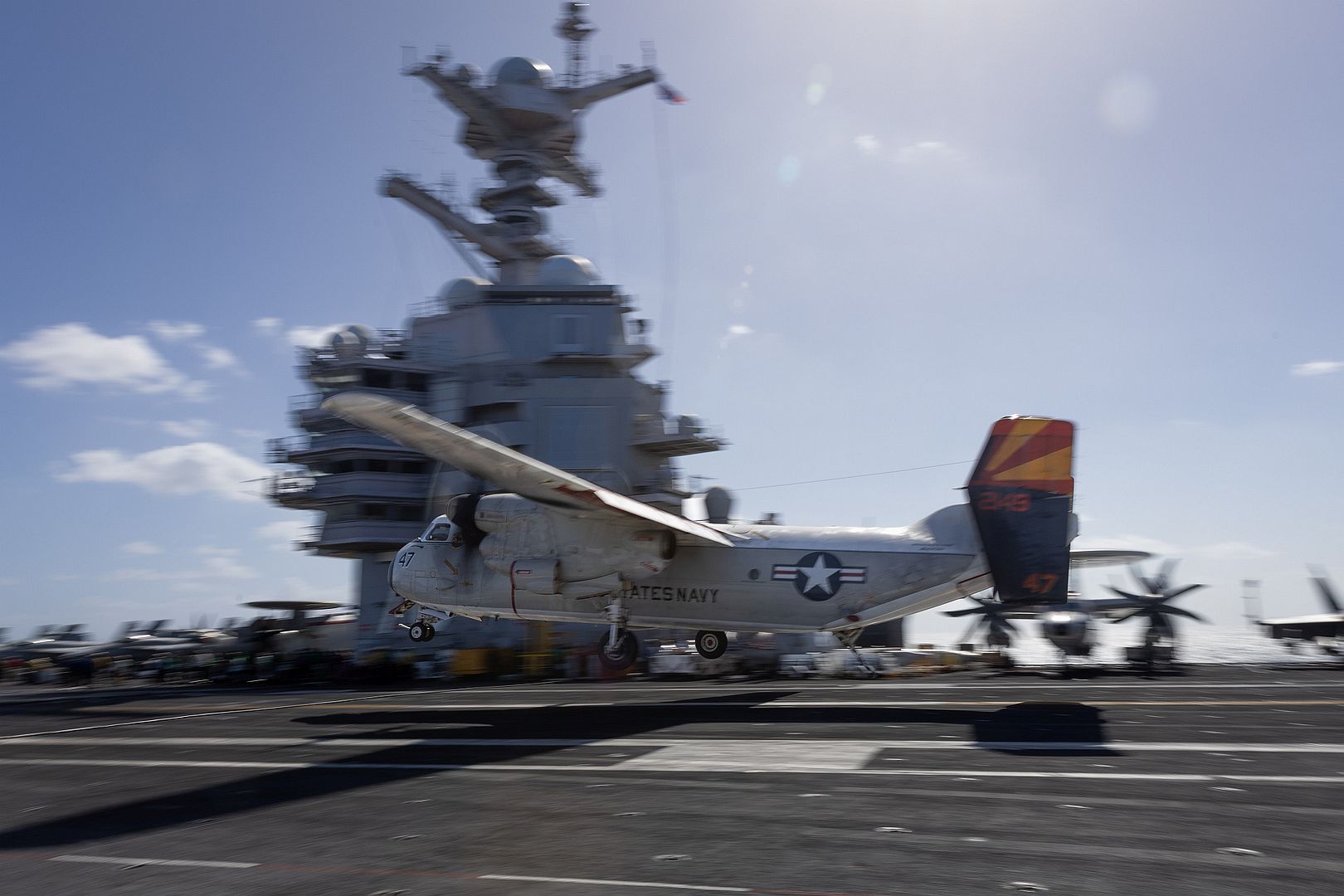
The F-35 Patuxent River Integrated Test Force team, U.S. Sailors and Marines, and the ship’s company of Japan Maritime Self-Defense Force Izumo-class multi-functional destroyer JS Kaga (DDH-184) perform night flight test during developmental sea trials Oct. 30, 2024, in the Pacific Ocean. The team embarked on the MSDF’s largest ship are aboard to gather the necessary data to certify F-35B Lightning II short takeoff and vertical landing aircraft operations. The Pax ITF flight test team has been gathering compatibility data for analysis to make recommendations for future F-35B operational envelopes, further enhancing the Japanese navy's capabilities. The results of the testing will contribute to improved interoperability between Japan and the United States, strengthening the deterrence and response capabilities of the Japan-U.S. alliance, and contributing to peace and stability in the Indo-Pacific region. Japan is an F-35 Joint Program Office foreign military sales customer planning to purchase 42 F-35Bs. The F-35 Joint Program Office continues to develop, produce, and sustain the F-35 Air System to fulfill its mandate to deliver a capable, available, and affordable air system with fifth-generation capabilities.
(Photos by Dane Wiedmann)

A U.S. Air Force KC-46A Pegasus assigned to the 91st Expeditionary Air Refueling Squadron prepares to land within the U.S. Central Command area of responsibility, Oct. 5, 2024. The KC-46 is the U.S. Air Force’s newest air refueler. The addition of next generation air refueling support to the Ninth Air Force’s (U.S. Air Forces Central) enhances U.S. capabilities to promote peace and stability throughout the region. (U.S. Air Force photo)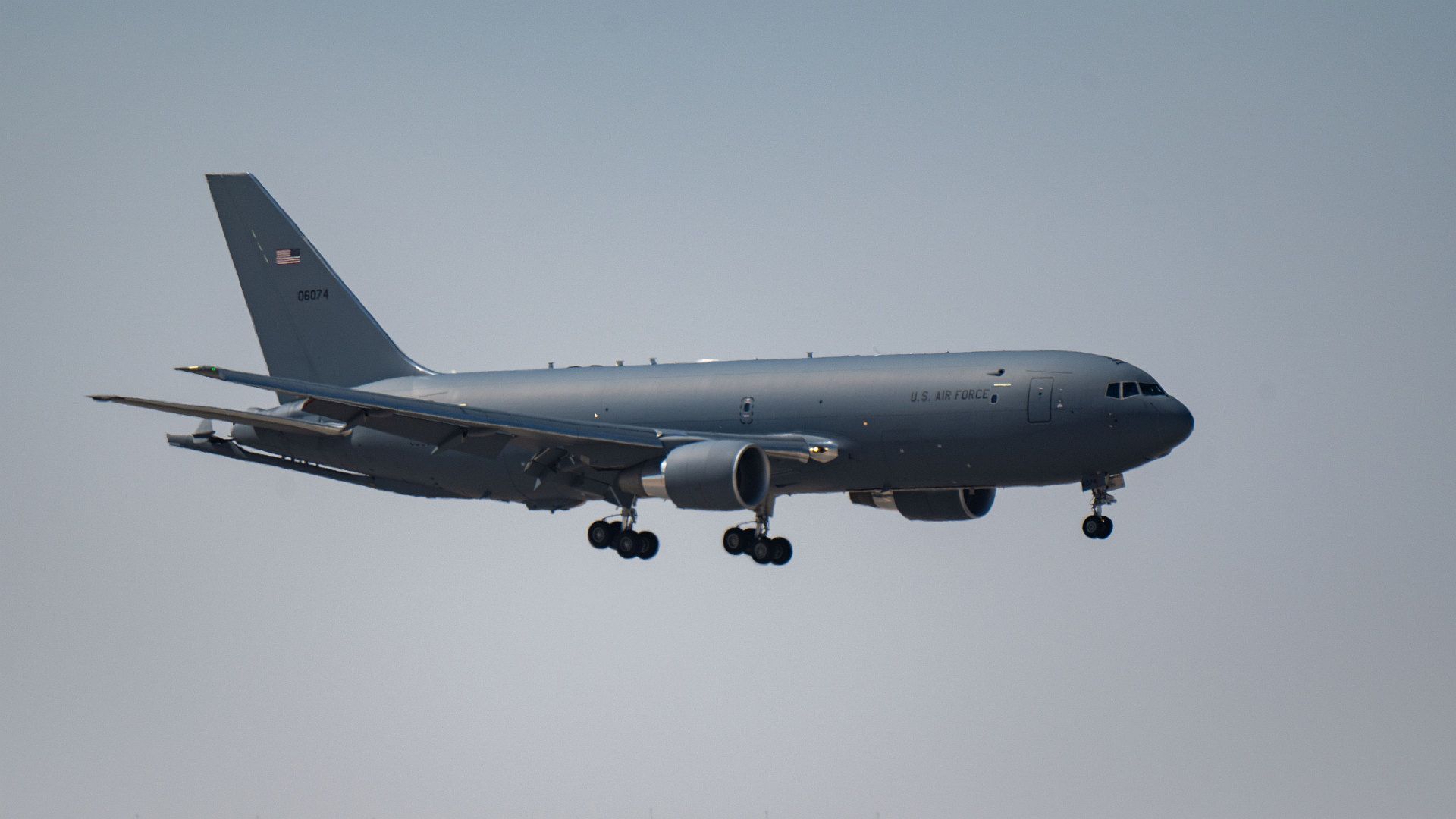
A U.S. Air Force KC-46A Pegasus assigned to the 305th Expeditionary Air Refueling Squadron sits on a flightline within the U.S. Central Command area of responsibility, Oct. 8, 2024. The KC-46A, a next-generation airframe, is equipped with a number of self-protection, defensive and communication features, which increases survivability in contested environments. (Photo by Airman 1st Class Zeeshan Naeem)
ROLLING MEADOWS, Ill. – Oct. 31, 2024 – (PHOTO RELEASE) Northrop Grumman Corporation’s (NYSE: NOC) LITENING targeting pod has completed initial flight testing on the U.S. Navy F/A-18 E/F Super Hornet aircraft, a critical step on the path to fleet operations. The tests put the electro-optical/infrared pod through a set of demanding maneuvers representative of operational scenarios. LITENING’s daylight and infrared sensors provide high-definition video in multiple wavelengths to deliver a decisive advantage in surveillance and targeting missions.
October 31, 2024
Bombardier Celebrates 100th Challenger 3500 Aircraft Delivery, Underscoring Continued Success as Best-Selling Platform
Bombardier is proud to celebrate the delivery of the 100th Challenger 3500 aircraft, the latest addition to its industry-leading portfolio of aircraft. Since entering service in 2022, the Challenger 3500 aircraft has delivered unmatched versatility, the lowest direct operating costs in its class and rock-solid reliability, and quickly became a top choice for charter operators and corporations around the world. With this new milestone, the Challenger 3500 aircraft sets a new standard and becomes the fastest super-midsize business jet to reach 100 deliveries in history.
“The entire Bombardier team is proud that our super midsized jets have been the category’s best-sellers for more than a decade. Our customers continue to benefit from the comfort of the widest-in-class cabin and from the peace of mind provided by exceptional dispatch reliability of 99.8%. Passengers know that they can fly confidently on the Challenger 3500 aircraft, enjoying a spacious and refined cabin, while the aircraft consistently performs at the highest standards,” said, Jean-Christophe Gallagher, Executive Vice President, Aircraft Sales and Bombardier Defense. “The Challenger 3500 aircraft offers a remarkable travel experience, with a clear emphasis on comfort and passenger well-being. On top of its class-leading comfort, the Challenger 3500 also ensures that travel plans are consistently met without delays for a smooth and efficient journey.”
Leveraging some of the key features of Bombardier’s renowned Global family, the Challenger 3500 offers unparalleled comfort and luxury in the cabin, seamlessly integrating design and technology innovations. Passengers can enjoy Bombardier’s patented Nuage seat, the first new seat architecture in business aviation in over 30 years. When it comes to purposeful technology, the Challenger 3500 aircraft leads the way. It introduces several industry-first features, including voice-control, unmatched 4K entertainment, first-in-class wireless chargers and a true bring-your-own-device cabin philosophy, making it the leading-edge aircraft in its class.
Bombardier’s iconic Challenger family – the best-selling super mid-size platform for the past seven years – continues to lead the industry, with the Challenger 3500 recording a dispatch reliability of 99.8%.
SAN DIEGO – 31 October 2024 – General Atomics Aeronautical Systems, Inc. (GA-ASI) collaborated with BAE Systems to demonstrate unique electronic warfare (EW) capabilities remotely controlled via a secure, jam-resistant Link 16 network on an MQ-20 Avenger® unmanned aircraft system (UAS). The Avenger is a jet-powered platform used extensively as a test bed for autonomous UAS development and the Collaborative Combat Aircraft (CCA) program. The demonstration helps accelerate emerging networked electronic attack capabilities for U.S. Air Force Autonomous Collaborative Platforms (ACPs).
The demonstration took place at GA-ASI’s Desert Horizon flight operations facility in El Mirage, California, and is part of an ongoing series of technology insertion and autonomous flights performed using internal research and development funding to prove important concepts.
“This effort featured novel mission system capabilities and the viability of autonomous payload control on our MQ-20,” said Mike Atwood, Vice President of Advanced Programs at GA-ASI. “We’re identifying key areas for improvement, while sharing investment and reducing risk.”
BAE Systems provided customized mission technology that included EW capabilities, a multi-functional processor (MFP), and a Link 16 terminal. The company successfully tested the integrated solution in its System Integration Lab to identify and jam threats autonomously and under control of an operator. Command, control, and status of the EW system was made possible through software-based, open-mission-system (OMS) compliant message translation hosted on the MFP. A secure Link 16 networking waveform was used to disseminate this information.
“We are working closely with General Atomics to highlight the maturity of autonomous EW mission systems in support of U.S. Air Force objectives,” said Scott Bailie, director of Advanced Electronic Warfare Solutions at BAE Systems. “We are combining proven EW technology and secure command and control on a rapid timeline in a small form factor well-suited for CCAs.”
About GA-ASI
General Atomics Aeronautical Systems, Inc. (GA-ASI), an affiliate of General Atomics, is a leading designer and manufacturer of proven, reliable RPA systems, radars, and electro-optic and related mission systems, including the Predator® RPA series and the Lynx® Multi-mode Radar. With more than eight million flight hours, GA-ASI provides long-endurance, mission-capable aircraft with integrated sensor and data link systems required to deliver persistent situational awareness. The company also produces a variety of sensor control/image analysis software, offers pilot training and support services, and develops meta-material antennas.
For more information, visit www.ga-asi.com
BAE Systems, Inc. and its nearly 41,000 people are part of a global defense, aerospace, and security company with approximately 100,000 employees worldwide. We deliver products and services for air, land, sea and space, as well as advanced electronics, intelligence, security, and IT solutions and support services. Our dedication shows in everything we design, produce and deliver— to protect those who protect us in a high-performance, innovative culture. We push the limits of possibility to provide a critical advantage to our customers where it counts.
-
8 months ago
 Main AdminA U.S. Army CH-47 Chinook from the 10th Combat Aviation Brigade lands during a training mission in support of Combined Joint Task Force - Operation Inherent Resolve, Al-Tanf Garrison, Syria, Oct. 30, 2024. Large-scale, multi-capability exercises like these enhance Partner Forces' readiness to employ various tactics and capabilities to defeat ISIS at any time, in any place, across the region. (U.S. Army photo by Spc. Tyler Becker)
Main AdminA U.S. Army CH-47 Chinook from the 10th Combat Aviation Brigade lands during a training mission in support of Combined Joint Task Force - Operation Inherent Resolve, Al-Tanf Garrison, Syria, Oct. 30, 2024. Large-scale, multi-capability exercises like these enhance Partner Forces' readiness to employ various tactics and capabilities to defeat ISIS at any time, in any place, across the region. (U.S. Army photo by Spc. Tyler Becker)
U.S. Air Force Maj. Melanie "Mach" Kluesner, pilot for the F-35A Lightning II Demonstration Team, performs aerial maneuvers in a USAF F-35A, showcasing the jet's advanced capabilities during the practice day before an airshow at Pensacola NAS, Florida, Oct. 31, 2024. The Demo Team highlights the agility, speed, and precision of their jet, offering audiences a chance to witness the power and versatility of the United State's fifth-generation fighter. (U.S. Air Force photo by Senior Airman Nicholas Rupiper)
The United States Air Force Air Demonstration Squadron "Thunderbirds" perform a joint flyover with The United States Navy Flight Demonstration Squadron “Blue Angels” in Pensacola, Fla., Oct. 30, 2024. The Thunderbirds and Blue Angels kicked off the 2024 season training together in El Centro, Calif. and concluded the season with a rare joint air show at NAS Pensacola; demonstrating the exceptional precision and teamwork of each branch’s aerial demonstration team. (U.S. Air Force photo by Staff Sgt. Dakota Carter)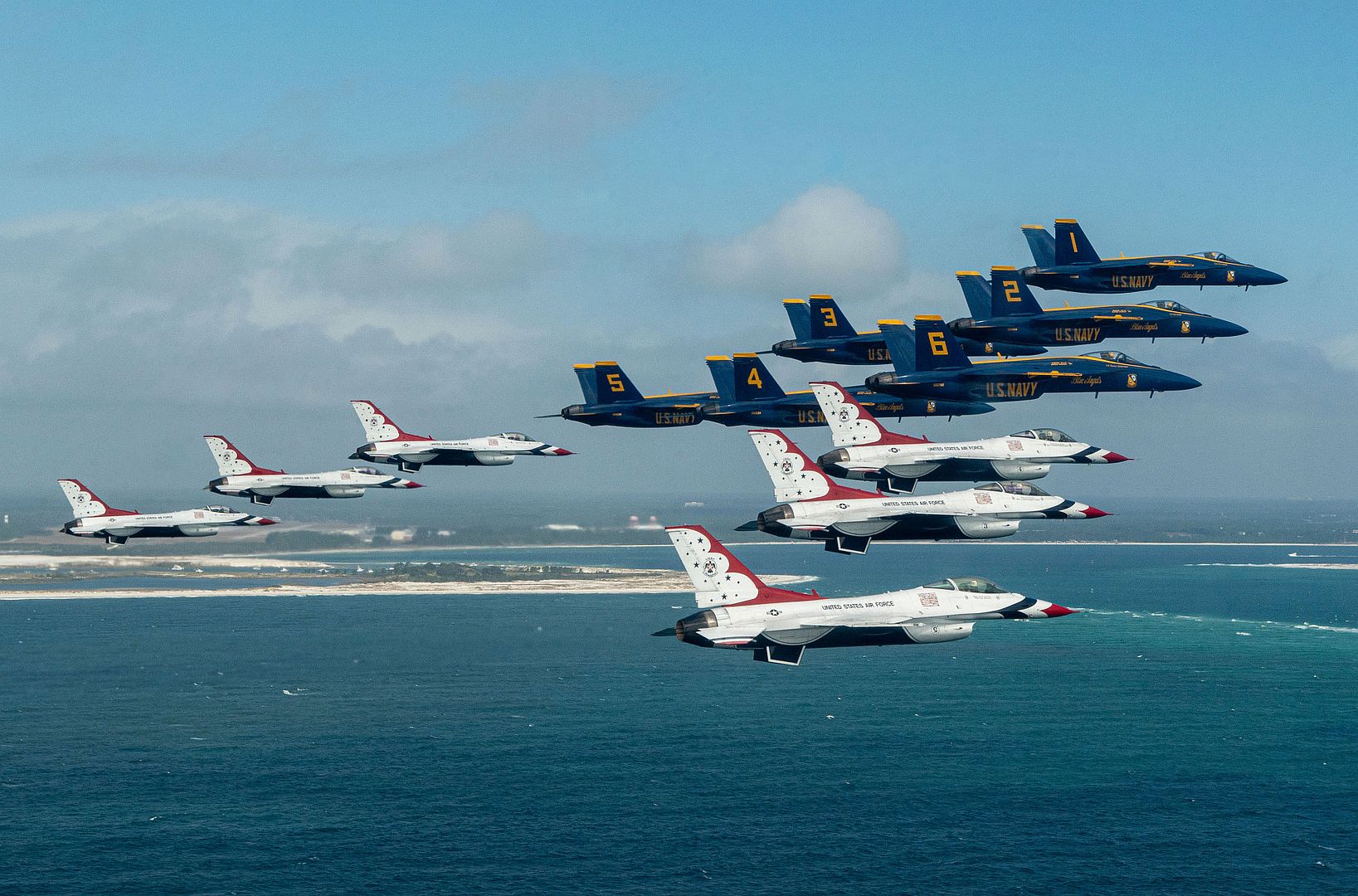
Three U.S. Air Force F-16 Fighting Falcons, four Japan Air Self-Defense (JASDF) F-2s and four JASDF F-35 Lightning IIs, from Misawa Air Base, fly in formation near the west coast of Japan, Oct. 31, 2024. (U.S. Air Force Courtesy Photo)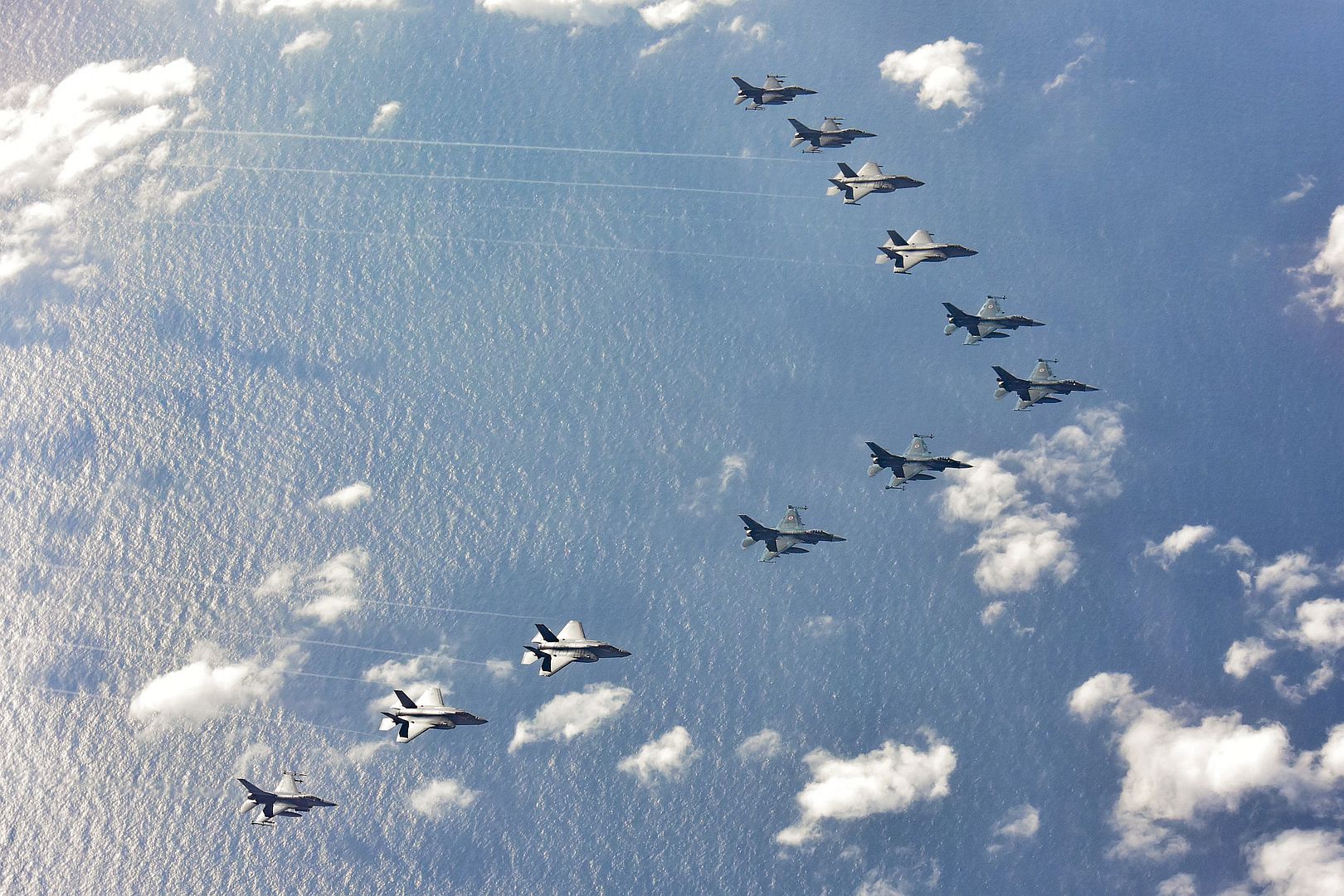
A U.S. Marine Corps F/A-18D Hornet assigned to Marine Fighter Attack Squadron 232, approaches a U.S. Air Force KC-135 Stratotanker assigned to the 909th Air Refueling Squadron to conduct aerial refueling during a Keen Sword 25 training mission over the Sea of Japan, Oct. 31, 2024. Keen Sword is a biennial, joint and bilateral field-training exercise involving U.S. military and Japan Self-Defense Force personnel, designed to increase readiness and interoperability while strengthening the ironclad U.S.-Japan alliance. (U.S. Air Force photo by Senior Airman Tylir Meyer)
A U.S. Marine Corps F/A-18D Hornet assigned to Marine Fighter Attack Squadron 232, conducts aerial refeuling with a U.S. Air Force KC-135 Stratotanker assigned to the 909th Air Refueling Squadron, before a Keen Sword 25 training mission over the Sea of Japan, Oct. 31, 2024. Keen Sword is a biennial, joint and bilateral field-training exercise involving U.S. military and Japan Self-Defense Force personnel, designed to increase readiness and interoperability while strengthening the ironclad U.S.-Japan alliance. (U.S. Air Force photo by Senior Airman Tylir Meyer)
-
8 months ago
 Main AdminAn F/A-18F Super Hornet, assigned to the “Blacklions” of Strike Fighter Squadron (VFA) 213, prepares for launch on the flight deck of the world’s largest aircraft carrier, USS Gerald R. Ford (CVN 78), during routine flight operations, November 1, 2024. USS Gerald R. Ford, the flagship of the Gerald R. Ford Carrier Strike Group, is currently underway in the U.S. 2nd Fleet area of operations, conducting Surface Warfare Advanced Tactical Training (SWATT). SWATT is the surface force’s premiere advanced tactical training exercise that increases war-fighting capability and tactical proficiency across all domains. (U.S. Navy photo by Mass Communication Specialist Seaman Hector Rodriguez)
Main AdminAn F/A-18F Super Hornet, assigned to the “Blacklions” of Strike Fighter Squadron (VFA) 213, prepares for launch on the flight deck of the world’s largest aircraft carrier, USS Gerald R. Ford (CVN 78), during routine flight operations, November 1, 2024. USS Gerald R. Ford, the flagship of the Gerald R. Ford Carrier Strike Group, is currently underway in the U.S. 2nd Fleet area of operations, conducting Surface Warfare Advanced Tactical Training (SWATT). SWATT is the surface force’s premiere advanced tactical training exercise that increases war-fighting capability and tactical proficiency across all domains. (U.S. Navy photo by Mass Communication Specialist Seaman Hector Rodriguez)
An F-35B Lightning II aircraft taxis on the flight deck of Japan Maritime Self-Defense Izumo-class multi-functional destroyer JS Kaga (DDH 184) during developmental test Nov. 2, 2024, in the eastern Pacific Ocean. Flight deck handlers marshal Royal Navy Lt. Cmdr. Nick Baker, F-35 test pilot, a member of the F-35 Patuxent River Integrated Test Force (Pax ITF) assigned to Air Test and Evaluation Squadron Two Three (VX-23), as U.S. Marine Maj. Zach Laser, F-35 test pilot, Pax ITF, VX-23, refuels on the MSDF’s largest ship. Pax ITF flight test members, U.S. Sailors and Marines, and the JS Kaga crew are executing developmental test during these sea trials to gather the necessary compatibility data to certify F-35B Lightning II short takeoff and vertical landing aircraft operations. Following analysis, the test team will make recommendations for future F-35B operational launch and recovery envelopes, further enhancing the Japanese navy's capabilities. The results of the testing will contribute to improved interoperability between Japan and the United States, strengthening the deterrence and response capabilities of the Japan-U.S. alliance and strengthening the security environment in the Indo-Pacific region. Japan is an F-35 Joint Program Office foreign military sales customer planning to purchase 42 F-35Bs. The F-35 Joint Program Office continues to develop, produce, and sustain the F-35 Air System to fulfill its mandate to deliver a capable, available, and affordable air system with fifth-generation capabilities.
(Photos by Dane Wiedmann)

ANDAMAN SEA (Nov. 3, 2024) – A Royal Malaysian Navy Eurocopter AS 550 Fennec helicopter lands on the flight deck aboard the Arleigh Burke-class guided-missile destroyer USS Dewey (DDG 105) while operating in the Andaman Sea during Cooperation Afloat Readiness and Training (CARAT) Malaysia, Nov. 3, 2024. CARAT Malaysia 2024 is a biennial exercise that seeks to enhance collaboration focused on shared maritime security challenges in the region. In its 30th year, CARAT 2024 highlights the longstanding role of regular collaboration as a credible venue for regional Allies and partners to address shared maritime security priorities. (U.S. Navy photo by Mass Communication Specialist 1st Class Greg Johnson)
B-52H Stratofortress strategic bombers from Minot Air Force Base’s 5th Bomb Wing arrived in the U.S. Central Command area of responsibility Nov. 2, 2024. (Photo by Airman 1st Class Zeeshan Naeem)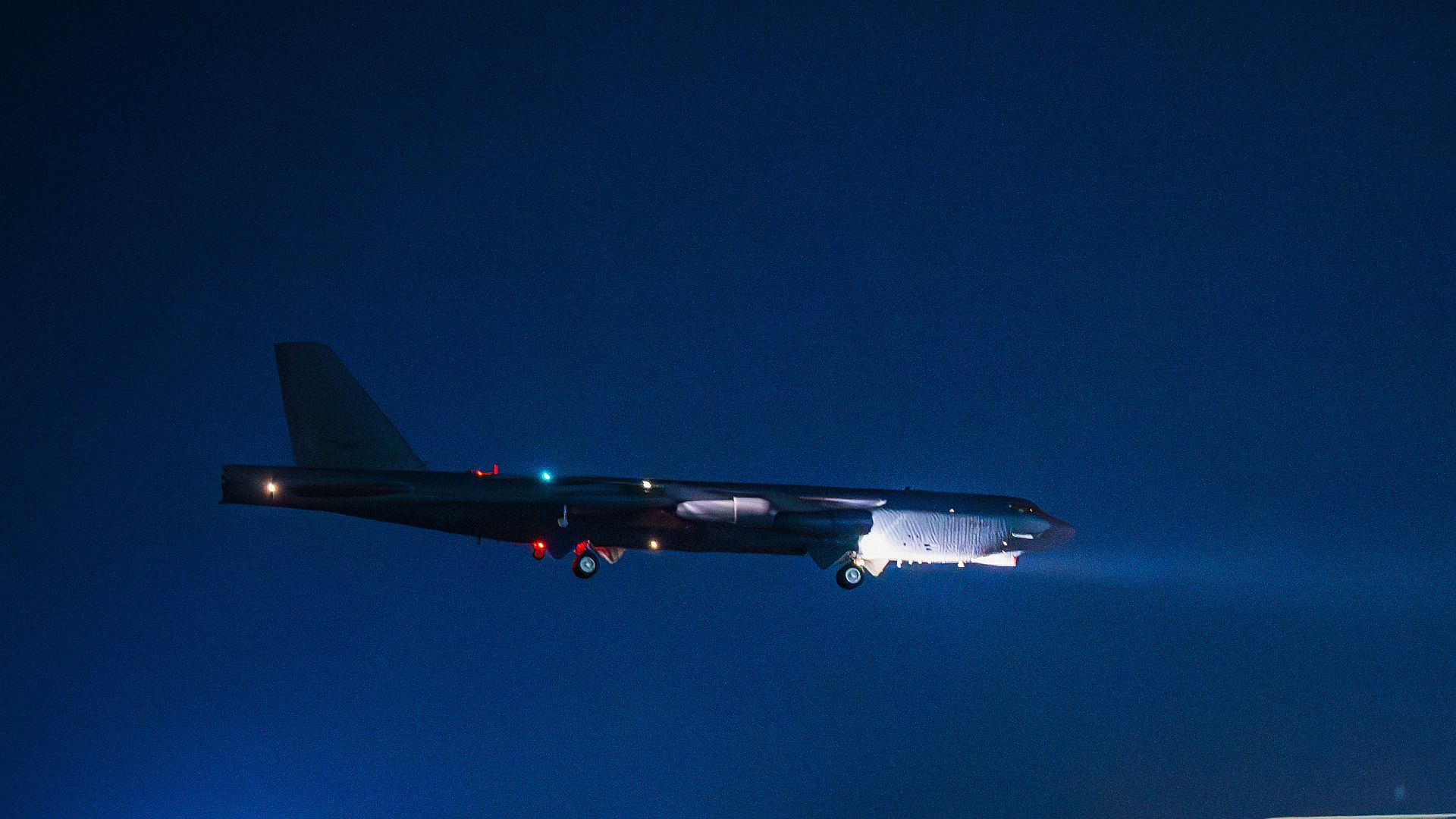
Civilians and 104th Fighter Wing service members take part in Employer Support of the Guard and Reserve (ESGR) flight on a KC-135 Stratotanker from the 101st Air Refueling Wing, Maine Air National Guard on Nov. 1 and 2, 2024, at Barnes Air National Guard Base, Massachusetts.
The event was part of the DoD's program, which fosters a deeper understanding between reserve service members and the companies they work for.
"ESGR is an all volunteer organization which seeks to gain and maintain employer support for the men and women who serve in the Guard and Reserve," said Earl Bonnet, chair emeritus for Massachusetts Employer Support for the Guard.
(U.S. Air National Guard courtesy photos)
The new F-35 Lightning II stands on display at the First Aircraft Arrival ceremony on Nov. 2, 2024, at Naval Air Station Joint Reserve Base Fort Worth, Texas. The delivery of the F-35 ushered in a new era of modern-day warfighting for the U.S. Air Force. (U.S. Air Force photo by Staff Sgt. Richard Moser)
Airmen from the 388th Fighter Wing marshal F-35A Lightning IIs at Hill Air Force Base, Utah, Oct. 22, 2024. Airmen from the 388th Fighter Wing participated in a week-long agile combat exercise. During the exercise, Airmen from diverse specialties demonstrated their ability to deploy, establish, receive, re-arm, refuel, and launch aircraft from various mountain west locations. (U.S. Air Force photos by R. Nial Bradshaw)


Fort Erie, Canada - Airbus Helicopters has signed a landmark contract with SkyAlyne, a joint venture between Canadian defence leaders CAE and KF Aerospace, to provide the Royal Canadian Air Force (RCAF) with 19 Airbus H135 helicopters to train the next generation of RCAF Pilots. The contract is part of Canada’s Future Aircrew Training (FAcT) Program and marks the first time that Airbus helicopters will fly as part of the Canadian Armed Forces.
The twin-engine helicopters will be completed and delivered from Airbus Helicopters’ industrial facility located in Fort Erie, Ontario, Canada. They will be customised with a number of Canadian developed Supplemental Type Certificates, including modifications to the avionics suite and communications systems, as well as custom development in the cockpit. Deliveries are expected to begin in the first half of 2026.
“SkyAlyne is excited at the successful conclusion of negotiations between our partners at KF Aerospace and Airbus Helicopters in Canada, and we extend our gratitude to everyone involved. Securing the Airbus H135 fleet for the RCAF is an important milestone for SkyAlyne and the FAcT Program as it solidifies a core element of the program schedule,” commented Kevin Lemke, SkyAlyne’s senior executive. “The selection of the state-of-the-art H135 from Airbus Helicopters contributes meaningfully to the Canadian economy and SkyAlyne is proud to be building a world-leading Pilot and Aircrew training program for the RCAF while supporting Canadian jobs.”
“Entering into this partnership with SkyAlyne and the Department of National Defence is a historic moment for Airbus Helicopters in Canada. We thank the Royal Canadian Air Force for placing their trust in Airbus and the H135, joining 12 other militaries around the world that employ the twin-engine H135 to train future aviators,” said Dwayne Charette, President of Airbus Helicopters in Canada. “This contract marks Airbus Helicopters’ successful entry into the Canadian military market. As we celebrate 40 years of serving Canadian customers locally, we are honoured to contribute to the safety of Canadians for many years to come.”
The agreement consists of H135 aircraft acquisition and a support and services package, support for the development of a Ground-Based Training Solution, and advanced engineering support for the release to service.
With more than 400,000 flight hours in a dedicated military training role, the H135 is utilised for basic ab-initio, advanced IFR and tactical training, with operators including several of Canada’s close military allies such as Australia and the UK. A full spectrum training aircraft, the H135 facilitates the development of core skills while providing twin-engines and advanced avionics, allowing easy and safe pilot transition to more complex helicopters in the RCAF’s fleet. It joins other Airbus aircraft currently operating for Canadian defence, such as the Airbus 310 (CC150 Polaris), the Airbus A330 Multi Role Tanker Transport (CC330 Husky), and the Airbus C295 (CC295 Kingfisher).
Since 1984, Airbus Helicopters has delivered nearly 600 helicopters in Canada. In 2023, the Canadian fleet of 760 in-service helicopters accumulated over 275,000 flight hours. The Fort Erie facility is also the centre of excellence for light single gearboxes, and the single source for critical composite components supporting platforms worldwide. Each year, Airbus Helicopters ships 34,000 parts from Fort Erie to customers around the globe.
In Canada, more than 4,500 people work at ten Airbus locations, covering the commercial airliner, helicopter, defence and space sectors. Airbus' presence in Canada contributes to approximately 23,000 indirect jobs and generates more than C$ 2 billion in revenues annually for more than 850 Canadian companies.
Fort Worth, TX (November 4, 2024) - Bell Textron Inc., a Textron Inc. (NYSE: TXT) company, announced the signed purchase agreement for the sale of a second Bell 505 to the Fort Worth Police Department.
“Bell is proud the Fort Worth Police Department has chosen to expand their existing all-Bell public safety fleet with the purchase of an additional Bell 505, continuing our long-standing relationship with the Department,” said Lane Evans, managing director, North America. “We remain confident that the Bell 505 platform will continue to be a great asset to the community and surrounding areas for years to come.”
Since its inception, the Fort Worth Police Department Air Support Unit has used a series of Bell aircraft to advance their aerial public safety capabilities, including Bell 47s and Bell 206 Jet Rangers. In 2021, the Department took delivery of their first Bell 505 during a ceremony that commemorated the 70-year relationship between Bell and the Department.
With the Air Support Unit’s newly purchased Bell 505, the Department plans to increase their public safety presence with the platform’s versatile-mission capabilities, such as search and rescue missions. With the added benefit of its wide panoramic windows, open cabin design, and Synthetic Vision technology, the Bell 505 acts as a force-multiplier by allowing aerial crews to relay essential safety information to law enforcement officers on the ground. Combining its Safran Arrius 2R engine, dual channel FADEC, and Garmin G1000H NXi avionics suite, the Bell 505 was manufactured to perform efficiently during demanding missions.
One of 51 Squadron’s Rivet Joints has arrived from Offutt Air Force Base - home of the United States Air Force 55th Wing - to Naval Air Station (NAS) Fallon in the USA, following a transatlantic crossing from RAF Waddington.
The aircraft, crews, and engineers are taking part in Exercise Resolute Hunter for the second year in a row. This dedicated 3-week Battle Management, Command & Control, Intelligence, Surveillance, Reconnaissance, and Fires exercise is run by the U.S. Navy and hosted by the Maritime Intelligence, Surveillance and Reconnaissance Weapons School (MISRWS) at NAS Fallon, Nevada.
Confronted by land and maritime scenarios, participants must understand, orientate then act as a combined and joint force.
(Photo courtesy of the RAF)
-
8 months ago
 Main AdminA CMV-22 Osprey tiltrotor aircraft, assigned to Fleet Logistics Multi-Mission Squadron (VRM) 30, prepares to take off from the flight deck onboard Nimitz-class aircraft carrier USS Ronald Reagan (CVN 76), while underway in the U.S. 3rd Fleet area of operations, Nov. 4, 2024. Ronald Reagan provides a combat-ready force that protects and defends the United States, and supports alliances, partnerships and collective maritime interests in the Indo-Pacific region. (U.S. Navy photo by Mass Communication Specialist 3rd Class Kazia Ream)
Main AdminA CMV-22 Osprey tiltrotor aircraft, assigned to Fleet Logistics Multi-Mission Squadron (VRM) 30, prepares to take off from the flight deck onboard Nimitz-class aircraft carrier USS Ronald Reagan (CVN 76), while underway in the U.S. 3rd Fleet area of operations, Nov. 4, 2024. Ronald Reagan provides a combat-ready force that protects and defends the United States, and supports alliances, partnerships and collective maritime interests in the Indo-Pacific region. (U.S. Navy photo by Mass Communication Specialist 3rd Class Kazia Ream)
A U.S. Navy F/A-18F and F-35, both assigned to Air Test and Evaluation Squadron (VX) 9, fly over the Point Mugu Sea Range in Southern California with a U.S. Air Force F-15 during Gray Flag 2024 on Sept. 24, 2024.(The F/A-18F carrying the new long range AIM-174B, and the new censor pod) Gray Flag is an annual large-force test event that brings the joint force together to test and evaluate multi-domain systems in a maritime environment, ensuring our nation’s warfighters are equipped with effective, interoperable systems that will help them deter aggression, protect our nation’s prosperity and security, and return home safely to their families. (U.S. Navy photos by Lt. Cmdr. Kory Hughs)



Fighter aircraft from the U.S., Japan, and the Republic of Korea conduct a trilateral escort flight of U.S. bombers operating in the Indo-Pacific, Nov. 3, 2024. Two U.S. F-16 from the 36th Fighter Squadron, 51st Fighter Wing flew with four Japan Air Self-Defense Force F-2s from the 8th Air Wing and four Republic of Korea Air Force F-15Ks from the 11th Fighter Wing to escort one U.S. Air Force B-1B Lancer. (U.S. Air Force photos by Senior Airman Maria Umanzor Guzman)

Toulouse, 05 November 2024 - Ethiopia’s national flag carrier and largest Airbus operator in Africa, Ethiopian Airlines, has taken delivery of its first of four A350-1000 from Airbus in Toulouse, France. The first of its kind to be operated by an african based operator, the A350-1000 will enable Ethiopian Airlines to enhance its premium service on key destinations including Washington D.C., London, Paris and Frankfurt.
To date Ethiopian Airlines operates a fleet of 21 A350 Family aircraft. A total of 14 additional A350 aircraft are set to join the airline’s fleet in the coming years, including 11 A350-900 and three additional A350-1000. The A350-1000 will provide great operational commonality with the A350-900 fleet, ensuring seamless integration with shared pilots and mechanics simplifying training and maintenance processes.
With a total capacity of 395 seats, the A350-1000 will increase Ethiopian Airlines’ passenger capacity and provide enhanced passenger experience in the largest business class cabin in the airline’s fleet. Ethiopian Airlines will also introduce Airbus' new HBCplus satcom connectivity solution, offering seamless, high-speed gate-to-gate connectivity.
The A350 is the world’s most modern and efficient widebody aircraft and the long-range leader in the 300-410 seater category. The A350’s clean sheet design includes state-of-the-art technologies and aerodynamics delivering unmatched standards of efficiency and comfort.
The A350’s unique Airspace cabin is the quietest of any twin-aisle in the sky featuring a 50% noise footprint reduction versus the previous generation aircraft. It offers passengers and crews the latest modern in-flight products for a comfortable flying experience. The aircraft’s new generation engines and use of lightweight materials make it the most fuel efficient large widebody aircraft.
As with all Airbus aircraft, the A350 aircraft is already able to operate with up to 50% Sustainable Aviation Fuel (SAF). Airbus is targeting to have its aircraft up to 100% SAF capable by 2030.
By the end of September 2024, 1,340 A350s had been ordered by 60 customers worldwide, making it one of the most successful widebody aircraft ever.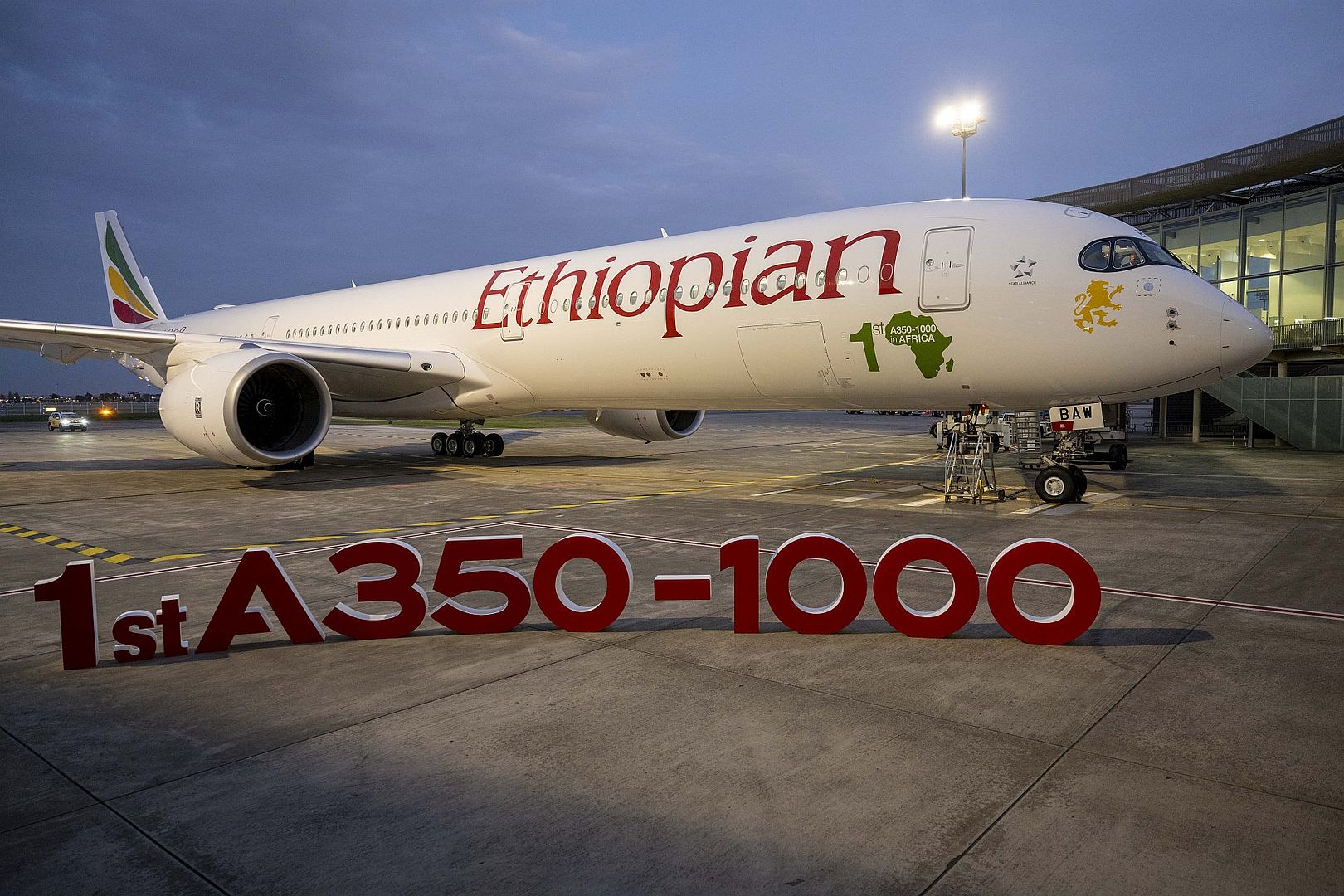
Paris - The Dutch Ministry of Defence has awarded a contract to Airbus Helicopters for 12 H225Ms. The contract also includes an initial batch of support and services. The agreement was signed by Vice-Admiral Jan Willem Hartman, Head of the Netherlands Command Materiel and IT (COMMIT) agency, and Bruno Even, CEO of Airbus Helicopters during the Euronaval trade show in Paris.
“We are very proud to see the Royal Netherlands Air Force and COMMIT renewing their trust in Airbus Helicopters. The H225M was selected by the Netherlands in June 2023 after a call for tender and an exhaustive evaluation, after which the Airbus helicopter was considered the best option for the very demanding special forces operations,” said Bruno Even, Airbus Helicopters CEO. “The proven H225M is unmatched in terms of performance,
versatility and range. It can carry extensive mission equipment that can be tailored to each customer's needs and will be serving its customer’s requirements for the decades to come,” he added.
The RNLAF currently operates Cougars from the H215M family. The H225Ms will be operated by the Royal Netherlands Air Force (RNLAF) 300 Special Operations Squadron. Airbus Helicopters and the RNLAF will work closely together on the development of the H225M adapted to the requirements of the users, enhancing capabilities and efficiency for special operations missions success, through tactical communication and a unique design of interaction of the aircraft and its systems.
The H225M has proven its reliability and durability in combat conditions and crisis areas. Benefiting from Airbus’ continuous improvement policy, the H225M is now equipped with new avionics, an enhanced main gear box, airborne communication systems and can be equipped with the HForce weapon system. The maximum take off weight has been increased by 160 kg to reach 11,160 kg.
There are more than 350 H225s and H225Ms in service around the world, totaling more than 880,000 flight hours. Military customers include France, Malaysia, Indonesia, Iraq, Thailand, Singapore, Mexico, Kuwait, Brazil, and Hungary.
Salt Lake City, Utah – Global Medical Response (GMR) has placed an order for 28 Airbus helicopters, including six H125s, five H130s, 14 H135s and three H145s, as it continues expanding its air medical fleet. Following GMR’s order of five Airbus helicopters earlier in 2024, the company will operate a fleet of nearly 200 Airbus helicopters, reinforcing its position as one of the largest operators of Airbus helicopters in North America.
Expanding on the 28 aircraft ordered, GMR will have options to purchase an additional 23 new Airbus helicopters over the next three years. With this order, GMR is anticipated to be among the first in North America to operate the IFR-capable H125.
“At Global Medical Response, we understand the critical impact air ambulances have in delivering rapid, lifesaving support when it’s needed most,” said GMR National President of Air Operations, Daniel Sweeza. “Our investment in Airbus helicopters strengthens our ability to deliver life-saving healthcare where care is needed the most. This expansion underscores our unwavering commitment to accessible, advanced care – ensuring that, regardless of where patients are, we can be there to make a difference when every second matters.”
GMR is a leader in the air medical industry, with nearly 36,000 employees delivering compassionate, quality medical care across the U.S. and around the world. It operates 387 air base locations under brands including Air Evac Lifeteam, REACH Air Medical Services, Med-Trans Corporation, AirMed International and Guardian Flight. More than 30 Airbus helicopters have been added to GMR’s fleet since 2021.
“We are proud to continue supporting GMR as their teams work to deliver critical care to communities across the country, and pleased they have once again trusted Airbus helicopters to play a key role in their missions,” said Bart Reijnen, Head of the North America Region for Airbus Helicopters. “These additions reinforce GMR’s commitment to providing high quality medical care, and we look forward to the positive impact the new helicopters will have on their operations.”
As the leading provider of helicopters to the air medical transport industry, Airbus has supported North American operators in helicopter emergency medical services (HEMS) missions for more than 50 years. The single-engine H125 and H130 offer the best visibility in their class, as well as modular, open-space cabins ideally suited for HEMS missions. As the best performing single-engine helicopter, the H125 is particularly adapted to demanding hot and high environments.
The H135 is the market leader in HEMS worldwide, followed by the H145. Both helicopters are equipped with Airbus’ Helionix avionics suite, enhancing complementarity and enabling an almost seamless transition from one type to another, while their features enhance safety and reduce pilot workload. Their particularly low acoustic footprint make the H135 and the H145 the quietest helicopters in their class, while their CO2 emissions are the lowest amongst their direct competitors.
Gripen E makes its debut in multinational military exercise
Over two thousand military personnel from Brazil and 15 other nations from across Latin America, Africa, Europe and the United States are gathered for one of the largest operational air exercises in the Southern Hemisphere, CRUZEX 2024.
Held from 3 to 15 November at the Natal Air Base in Rio Grande do Norte, Brazil, the exercise features over 100 combat aircraft. The main highlight of this edition is the debut of the F-39E Gripen in high-complexity scenarios.
“It is a true honour to see Gripen E’s debut at CRUZEX. We have eagerly awaited this moment marking Gripen E’s first participation in a multinational military exercise. We are delighted that this impressive inaugural event is hosted by our valued customer and partner, the Brazilian Air Force,” said Micael Johansson, President and CEO of Saab.
As the most advanced fighter in service in Latin America, F-39E Gripen will execute a broad range of tasks in Composite Air Operations (COMAO), where a large number of aircraft with different objectives operate simultaneously against an enemy to saturate its defences, enhancing mission efficiency.
"At CRUZEX, we are acting both as enemy and friendly forces, the latter being our primary role. In this context, we will conduct Offensive Counterair operations (OCA), in which F-39E Gripen will protect friendly forces while they carry out actions within enemy territory, as well as air operations, and Defensive Counterair operations (DCA) aimed at defending against enemy attacks,” explained Lieutenant Colonel Aviator Ramon Lincoln Santos Fórneas, commander of the 1st Air Defence Group (1º GDA), the pioneering unit to operate the Gripen in the Brazilian Air Force.
In operation since December 2022, F-39E Gripen incorporates cutting-edge technologies, some of which are unprecedented in the Brazilian Air Force, such as the Active Electronically Scanned Array (AESA) radar and the Infra-Red Search and Track (IRST) passive targeting sensor. These sensors, along with its manoeuvrability, performance, communication, navigation, and electronic warfare systems, position F-39E Gripen as a strategic capability for maintaining the sovereignty of Brazilian airspace.
Salt Lake City, Utah (November 5, 2024) - Bell Textron Inc., a Textron Inc. (NYSE: TXT) company, announced the signed purchase agreement for the sale of fifteen Bell 407GXis outfitted with IFR configuration kits to Global Medical Response with an option to purchase nine additional aircraft, bringing its total fleet to 250 Bell helicopters.
“Bell is proud to continue our relationship with Global Medical Response, one of the largest air medical service operators in the world. We are thrilled with our customer’s decision to expand its fleet with the Bell 407GXi platform,” said Danny Maldonado, chief commercial officer, Bell. “When it comes to our air medical operators getting to their patients, we recognize that minutes matter. With the Bell 407GXi, operators benefit from its advanced capabilities and reliability that gets them quickly to where it matters most.”
With 387 operational bases across all 50 U.S. states and internationally, Global Medical Response provides life-saving care as the largest end-to-end provider of acute out-of-hospital patient care. Global Medical Response’s air entities support emergent and non-emergent air missions, including critical care transport and emergency disaster response.
Adding the capabilities of these fifteen new Bell aircraft will support Global Medical Response in its plans to expand the system’s footprint to help more patients in need.
“At Global Medical Response, we recognize the vital role air ambulances play in providing timely, life-saving care across a diverse landscape,” said Daniel Sweeza, National President of Air Operations for Global Medical Response. “Expanding our fleet allows us to further bridge the gap of access to healthcare. With this expansion, we are reinforcing our commitment to being there when every second counts, ensuring that patients have rapid access to advanced critical care, no matter where they are.”
Delivering impressive performance and fuel efficiency with the ability to cruise at 133 kts (246 km/h), the Bell 407GXi remains one of the top platforms for air medical agencies located throughout the world. With single-pilot IFR capability and adjustable cabin space, the Bell 407GXi allows operators to perform in demanding environments while carrying essential medical equipment needed during emergency missions.
-
7 months ago
 Main AdminU.S. Air Force F-35A Lightning IIs assigned to the 34th Fighter Squadron, Hill Air Force Base, Utah, sits under a shelter at Kadena Air Base, Japan, Nov. 4, 2024. The transition to more modern aircraft at Kadena exemplifies the U.S. Air Force’s continued commitment to enhancing posture and building on the strong foundation of the U.S.-Japan alliance. (U.S. Air Force photos by Airman 1st Class Amy Kelley)
Main AdminU.S. Air Force F-35A Lightning IIs assigned to the 34th Fighter Squadron, Hill Air Force Base, Utah, sits under a shelter at Kadena Air Base, Japan, Nov. 4, 2024. The transition to more modern aircraft at Kadena exemplifies the U.S. Air Force’s continued commitment to enhancing posture and building on the strong foundation of the U.S.-Japan alliance. (U.S. Air Force photos by Airman 1st Class Amy Kelley)
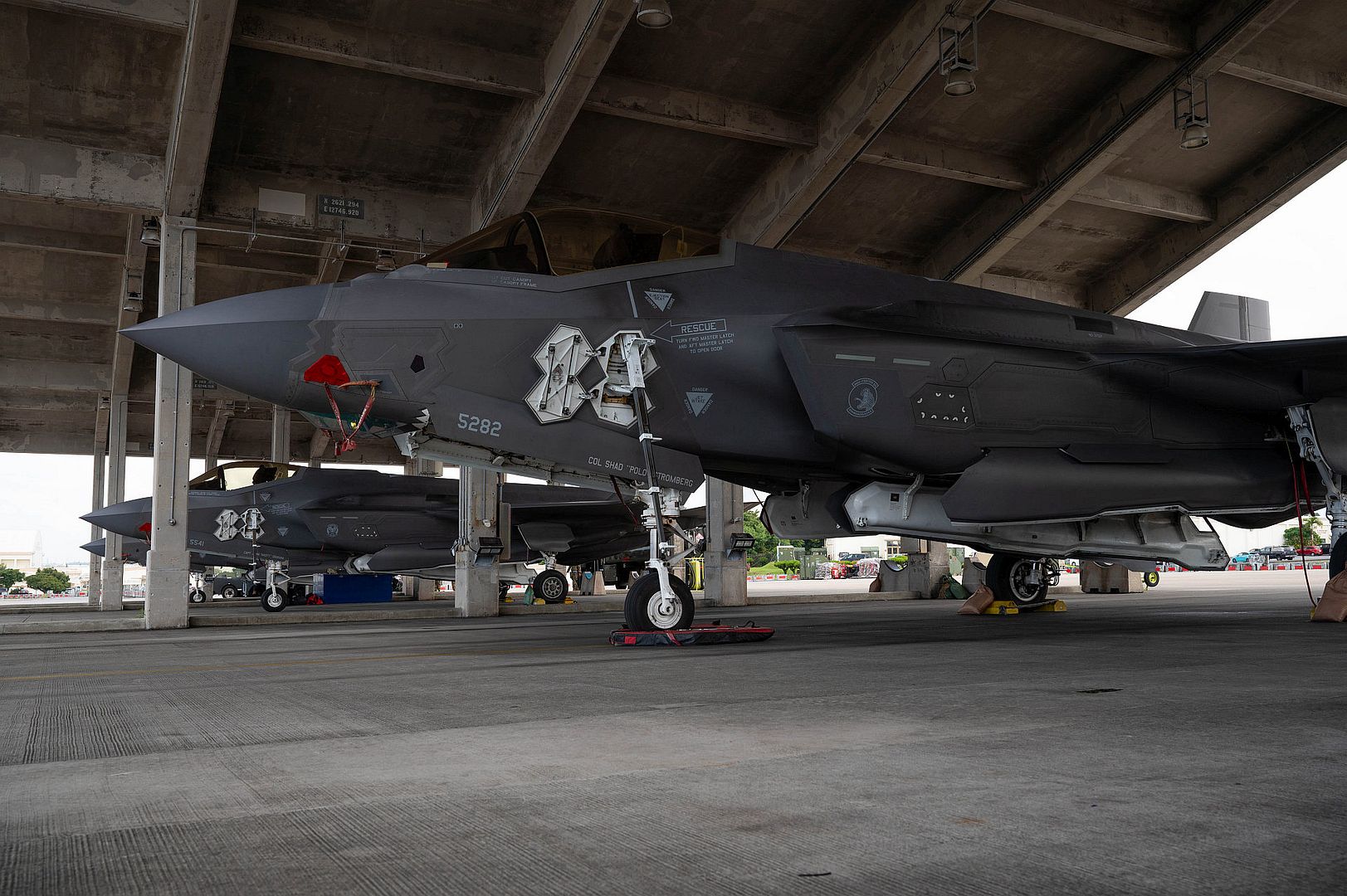
A KC-135 Stratotanker assigned to the 351st Air Refueling Squadron refuels an RC-135 Rivet Joint assigned to the 95th Reconnaissance Squadron over Norway, Nov. 5, 2024. The RC-135 Rivet Joint reconnaissance aircraft supports theater and national-level consumers with near real time, on-scene intelligence collection, analysis and dissemination capabilities. (U.S. Air Force photo by Airman 1st Class Aidan Martinez)
A U.S. Air Force F-15C Eagle participates in an aerial formation for a media flight during CRUZEX 2024 over Natal, Brazil, Nov. 4, 2024. These collaborative efforts are essential to strengthening partnerships that promote peace and stability worldwide. (U.S. Air Force photos by Staff Sgt. Madeline Herzog)


The Utah Air National Guard’s KC-135R Stratotanker waiting, ready, on the flightline to begin the mission, during a Nuclear Operational Readiness Exercise, Nov. 2, 2024, at Hill AFB. The NORE provides an opportunity to communicate the evolving capabilities of the 151st Wing in the context of the Global Power Competition, aiming to enhance operational readiness, test multi-capable Airmen, and develop new tactics and procedures in response to the threat posed by near-peer adversaries. (U.S. Air National Guard photo by Master Sgt. Nicholas Perez)
The Utah Air National Guard’s KC-135R Stratotanker takeoff during a Nuclear Operational Readiness Exercise, Nov. 2, 2024, at Hill AFB. The NORE provides an opportunity to communicate the evolving capabilities of the 151st Wing in the context of the Global Power Competition, aiming to enhance operational readiness, test multi-capable Airmen, and develop new tactics and procedures in response to the threat posed by near-peer adversaries. (U.S. Air National Guard photo by Master Sgt. Nicholas Perez)
U.S. Air Force Capt. Rhett Spongberg, 510th Fighter Squadron F-16 Fighting Falcon pilot, flies over Aviano Air Base, Italy, Oct. 29, 2024. Integrating with NATO allies and partners maintains U.S. readiness and commitment in the European Theater. (U.S. Air Force photo by Airman 1st Class Joseph Bartoszek)
An A-10 Thunderbolt II assigned to the 124th Fighter Wing, Boise, Idaho, taxis out for a Green Flag-West 25-02 mission at Nellis Air Force Base, October 29, 2024. Green Flag-West is primarily executed in conjunction with US Army exercises at the National Training Center at Ft Irwin, California, but also trains against sea-based threats in order to provide multi-domain air-to-surface fires training. (U.S. Air Force photo by William R. Lewis)
An E-2C Hawkeye aircraft assigned to Airborne Command & Control Squadron (VAW) 123 prepares to land Davis-Monthan Air Force Base, the largest aircraft boneyard in the world in Tucson, in September 2024. VAW-123 transferred two of their four E-2C Hawkeye aircraft to the boneyard. This event was part of the squadron's transition to the E-2D Advanced Hawkeye to be completed in mid-2025. (U.S. Navy photo)
Amsterdam - Airbus and Østnes Helicopters, the official distributor for Airbus Helicopters in the Nordic countries, announced a contract for ten Airbus H125s at this year's European Rotors. They will join a fleet of more than 150 H125s in the region, which mainly perform utility and aerial work missions.
"Nordic customers require a truly versatile helicopter which can perform a wide range of missions," said Frode Østnes, CEO of Østnes Helicopters. "The H125 has proven that it has the capabilities time and again. Our customers in the region depend on these aircraft for essential missions and we are determined to ensure they benefit from short delivery times. This order ensures we have the best availability for the best helicopter.”
"With the contract for ten H125s, we are proud to write another chapter in our more than 30-year partnership with Østnes Helicopters," said Thomas Hein, Head of Europe Region at Airbus Helicopters. "The H125 is the world's most successful single-engine helicopter and we are happy that Østnes is strongly committed to supporting our ambition to expand our market share in the Nordic region. With this agreement we look forward to further strengthening our presence in this region.”
Østnes Helicopters is the authorised distributor for Airbus helicopters in the Nordic countries. The company has established a strong presence in the rotorcraft sector in the region and has successfully sold more than 400 helicopters, both new and on the secondary market. Østnes Helicopters' maintenance organisation is approved to provide full MRO services for the H120, H125 and H130 models. From this year, its scope also includes full support for the H145, supported by a team of certified technicians and avionics experts specially trained for the H145 helicopter.
Today, more than 4,300 H125 family helicopters are flying across the globe in the most demanding conditions. The H125 is the absolute market leader in the intermediate single-engine helicopter category, achieving a record market share of 82% in 2023. This year, the Ecureuil family celebrates 40 million flight hours and 50 years since its maiden flight.
-
7 months ago
 Main AdminAn F-16D aircraft is parked at the 171st Air Refueling Wing, Pittsburgh, Pennsylvania November 5, 2024. The F-16 is assigned to the 20th Fighter Wing, Shaw Air Force Base, South Carolina. (U.S. Air National Guard photo by Master Sgt. Bryan Hoover)
Main AdminAn F-16D aircraft is parked at the 171st Air Refueling Wing, Pittsburgh, Pennsylvania November 5, 2024. The F-16 is assigned to the 20th Fighter Wing, Shaw Air Force Base, South Carolina. (U.S. Air National Guard photo by Master Sgt. Bryan Hoover)
A B-52 Stratofortress assigned to the 2nd Bomb Wing, Barksdale Air Force Base, Louisiana, approaches a KC-135 Stratotanker assigned to the 6th Air Refueling Wing, MacDill AFB, Florida, for fuel over the southeastern United States, Nov. 5, 2024. The B-52 Stratofortress is a long-range, heavy bomber that can perform a variety of missions. As part of the Air Force Global Strike Command, the B-52 enables combat-ready forces to conduct strategic nuclear deterrence and global strike operations in support of combatant commanders. (U.S. Air Force photo by Tech. Sgt. Kris Echols)
Approximately 500 high school student leaders from 33 different schools and two local Reserve Officer Training Corps detachments attended a total force All-Star Leadership Day event Nov. 6, 2024, at the 171st Air Refueling Wing near Pittsburgh, Pennsylvania. Students had the opportunity to tour a KC-135 Stratotanker, a C-17 Globemaster and a F-16D Fighting Falcon aircraft as well as participate in teamwork exercises, leadership challenges, and interactive career exploration sessions. (U.S. Air National Guard photo by Tech. Sgt. Zoe M. Wockenfuss)
The 96th Test Wing's pilots performed a flyover at the Florida Gators football game Nov. 2. (U.S. Air Force photos by Samuel King Jr. 40th Flight Test Squadron)

A U.S. Air Force B-1B Lancer assigned to the 37th Bomb Squadron taxis on the runway at Ellsworth Air Force Base, S.D., after completing a CONUS-to-CONUS mission, Nov. 3, 2024. All missions are closely planned with the appropriate geographic combatant commands, Allies, and partners to ensure maximum training and integration opportunities as well as compliance with all national and international requirements and protocols. (U.S. Air Force photo by Airman Alec Carlberg)
PATUXENT RIVER, Md., Nov. 7, 2024 /PRNewswire/ -- Lockheed Martin (NYSE: LMT) collaborated with the U.S. Navy and General Atomics (GA) in a first-ever live control flight demonstration of an uncrewed system by the Unmanned Carrier Aviation Mission Control Station (UMCS).
Powered by the Skunk Works® MDCX™ autonomy platform, the UMCS controlled a GA MQ-20 Avenger uncrewed air system (UAS) as it completed a live fly mission. This demonstration is a pathfinder that helps to advance the complex technology necessary to enable crewed and uncrewed teaming as envisioned for programs such as CCA and others.
The flight test is a significant milestone in the development of UMCS, setting the stage for the Navy's future unmanned aviation operations.
MDCX™ enabled the U.S. Navy Air Vehicle Pilots at Patuxent River, Maryland to control the MQ-20 during its flight in California.
"Skunk Works is proud to collaborate with the Navy to bring its Carrier Air Wing of the Future vision to life," said John Clark, vice president and general manager, Lockheed Martin Skunk Works. "The MDCX made it possible to rapidly integrate the MQ-20 'autonomy core' with the UMCS, demonstrating common control capability and third-party platform integration."
"Autonomous collaborative platforms that are mission capable with technologies that have been demonstrated at high readiness levels and the maturation of those technologies is just one of the focus areas for GA-ASI," said GA-ASI President David R. Alexander. "This collaboration with the USN and Lockheed Martin advances the UMCS's beyond line-of-sight capabilities, while demonstrating the maturity of our Tactical Autonomy Core Ecosystem (TacACE)."
"This was a huge step for unmanned naval aviation," said Lt. Steven Wilster, MQ-25 AVP. "This demo showcased UMCS's first live control of an unmanned air vehicle, and it was great to be part of history in the making. The team is paving the way for integrating critical unmanned capability across the joint force to combat the high-end threat our warfighters face today and in the future."
The U.S. Navy, Air Force, and Marine Corps are collaborating via a Tri-Service Memorandum of Understanding on critical sub-systems for CCA platforms. The Navy leads the U.S. Department of Defense in developing a common control architecture and ground control station (GCS) for these systems. This work is being done in collaboration with Lockheed Martin Skunk Works, leveraging decades of operational experience delivering GCSs underpinned by the U.S. government's Open Mission Systems architecture for third-party platform integration for optimal interoperability.
The Navy will refine UMCS's requirements based on data from this demonstration and conduct further flight tests to advance command and control technologies, autonomy and crewed-uncrewed teaming.
SAN DIEGO – 07 November 2024 – On November 5, 2024, General Atomics Aeronautical Systems, Inc. (GA-ASI) used its MQ-20 Avenger® Unmanned Aircraft System to perform commanded autonomy maneuvers as part of a demonstration with the U.S. Navy (USN). The USN used its MD-5 Ground Control Station (GCS) with Lockheed Martin’s MDCX™ autonomy platform to command and control the jet-powered UAS. Working collaboratively with the USN and Lockheed Martin, the GA-ASI team successfully executed the flight demonstration over a Proliferated Low Earth Orbit (PLEO) datalink.
The USN’s Unmanned Carrier Aviation program office PMA-268 used GA-ASI’s MQ-20 as a surrogate to demonstrate how its Unmanned Carrier Aviation Mission Control Station (UMCS) can command a variety of unmanned aircraft. The MD-5 GCS was operated from the USN’s test facility at Patuxent River, Maryland, while the MQ-20 was flown out of GA-ASI’s Desert Horizon flight operations facility in El Mirage, California.
This flight was the first time a GA-ASI UAS completed bi-directional communications using the UMCS operation codes while performing autonomous behavior. The procedure was completed using the PLEO datalink.
“This effort was a prime example of industry partners and government agencies working together to perform important new capabilities,” said GA-ASI President David R. Alexander. “The team efficiently and safely demonstrated aircraft flight control from another government agency’s control station. Using GA-ASI’s Tactical Autonomy Core Ecosystem (TacACE) software, the team not only executed airborne commands, but did so in a safe, controlled environment.”
The demonstration was part of an effort to advance technology for future Collaborative Combat Aircraft (CCA). GA-ASI initiated the demonstration between PMA-268 and Lockheed Martin’s Skunk Works to demonstrate connectivity between the Navy’s UMCS and GA-ASI’s MQ-20 Avenger. MQ-20 is a jet-powered platform used extensively as a CCA surrogate test bed for autonomous UAS technology development. GA-ASI was recently selected for the U.S. Air Force’s CCA program.
About GA-ASI
General Atomics Aeronautical Systems, Inc. (GA-ASI), an affiliate of General Atomics, is a leading designer and manufacturer of proven, reliable RPA systems, radars, and electro-optic and related mission systems, including the Predator® RPA series and the Lynx® Multi-mode Radar. With more than eight million flight hours, GA-ASI provides long-endurance, mission-capable aircraft with integrated sensor and data link systems required to deliver persistent situational awareness. The company also produces a variety of sensor control/image analysis software, offers pilot training and support services, and develops meta-material antennas.
For more information, visit www.ga-asi.com
-
7 months ago
 Main AdminA B-52H Stratofortress from the 2nd Bomb Wing, Barksdale Air Force Base, La., lands at Royal Air Force Base Fairford, England as part of Bomber Task Force 25-1, Nov. 5, 2024. U.S. presence is the most visible symbol of assurance and commitment to NATO Allies and provides deterrence against potential adversaries. (U.S. Air Force Photo by Airman 1st Class Laiken King)
Main AdminA B-52H Stratofortress from the 2nd Bomb Wing, Barksdale Air Force Base, La., lands at Royal Air Force Base Fairford, England as part of Bomber Task Force 25-1, Nov. 5, 2024. U.S. presence is the most visible symbol of assurance and commitment to NATO Allies and provides deterrence against potential adversaries. (U.S. Air Force Photo by Airman 1st Class Laiken King)
B-52H Stratofortresses assigned to the 2nd Bomb Wing lands at Royal Air Force Base Fairford, England, Nov. 8, 2024, in preparation for Bomber Task Force 25-1.The operational readiness of U.S. forces in all domains is vital to fostering strong partnerships, responding swiftly to crises, deterring threats and supporting our NATO Allies and partners. (U.S. Air Force photo by Senior Airman Mary Bowers)
A U.S. Air Force F-35A Lightning II assigned to the 301st Fighter Wing taxis on the flightline for the first time Nov. 5, 2024 at Naval Air Station Joint Reserve Base Fort Worth, Texas. The unit is officially the Air Force Reserve Command’s first stand-alone F-35 wing responsible for owning, maintaining and operating the F-35A mission. (U.S. Air Force photo by Staff Sgt. Celeste Zuniga)
Two F-35 Lightning IIs from the 388th Fighter Wing at Hill Air Force Base fly in formation with two T-38C Talons from the 25th Flying Training Squadron at Vance Air Force Base over the skies of Oklahoma, Oct. 31, 2024. During this sortie, the F-35 pilots demonstrated the flight capabilities of the F-35 to instructor pilots assigned to Vance Air Force Base. (U.S. Air Force photo by Senior Airman Christopher Ornelas Jr.)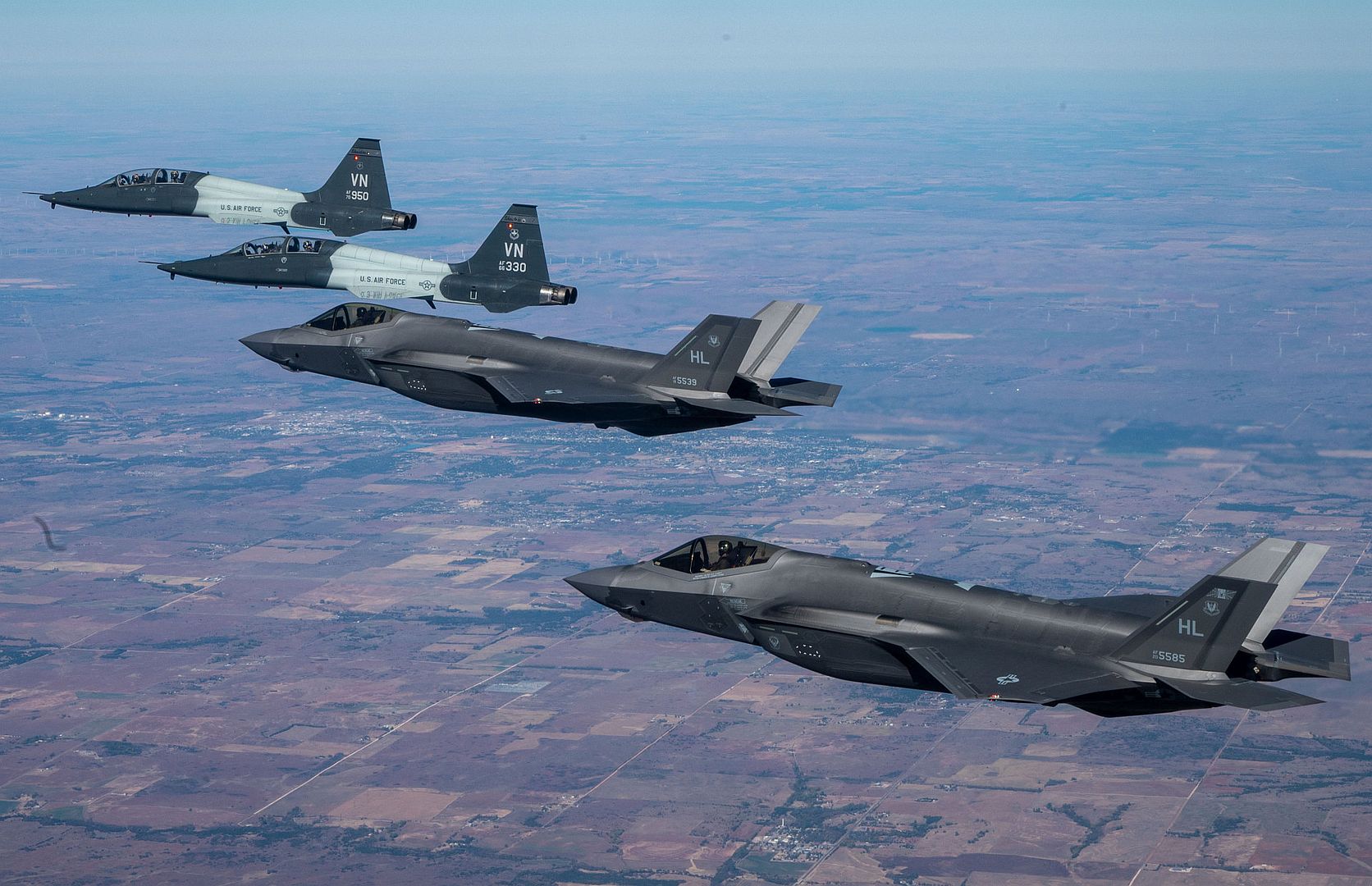
Rome, 08 November 2024
Leonardo has signed a contract with the General Command of the Port Authorities - Coast Guard for the supply of an ATR42-600 Maritime Patrol (MP) aircraft. The acquisition forms part of the General Command’s plan for renewal of its fleet of aircraft, which already includes three MPs based on the ATR 42-400 and the ATR 42-500.
The ATR 42 MP, developed and produced on the basis of the ATR 42-600 turboprop regional aircraft platform, is an aircraft perfectly expressing Leonardo's capabilities in terms of both platform and systems. The aircraft is equipped with multi-domain sensors and state-of-the-art research and communication systems, and is capable of transmitting and receiving information in real time, thereby optimising operations along the entire chain of command.
The ATR42 MP will be integrated into the Corps' aeronautical fleet to fulfil the multiple roles assigned to the Coast Guard, including maritime patrolling all along Italy’s coastline and in international waters, carried out with the aid of the advanced technological equipment integrated into its fixed and rotary wing aircraft.
Already in service with versions specially designed for other Italian government operators, the aircraft is equipped with Leonardo’s ATOS (Airborne Tactical Observation and Surveillance) modular mission system. ATOS manages the vast spectrum of aircraft sensors, combining the information received in a comprehensive tactical situation and presenting the results to operators in the most appropriate format to offer an excellent and constantly updated scenario of the situation, also in complex operations.
The aircraft integrates the reliability, maintainability, low life cycle cost and comfort of the ATR 42-600 from which it derives, while offering the crew a level of ergonomics that increases its efficiency and effectiveness during maritime patrol, search and identification, and SAR (search and rescue) missions, in the fight against drug trafficking, piracy and smuggling, and in the protection of territorial waters: missions that typically last more than 8 hours.
Taken during Exercise Bersama Lima 2024.
Established in 1971, the FPDA is a defensive arrangement between the nations of Australia, Malaysia, New Zealand, Singapore and the United Kingdom.
(Photos courtesy of the RAAF)

Holland, the weapons instructor course that began last May, ended today.
In recent weeks on Vliegbasis Leeuwarden it was take-off and landing of Dutch and Norwegian F-35s, also Belgium F-16s and the 'opponents', including Luftwaffe Eurofighter Typhoons!

(Photos courtesy of the Koninklijke Luchtmacht)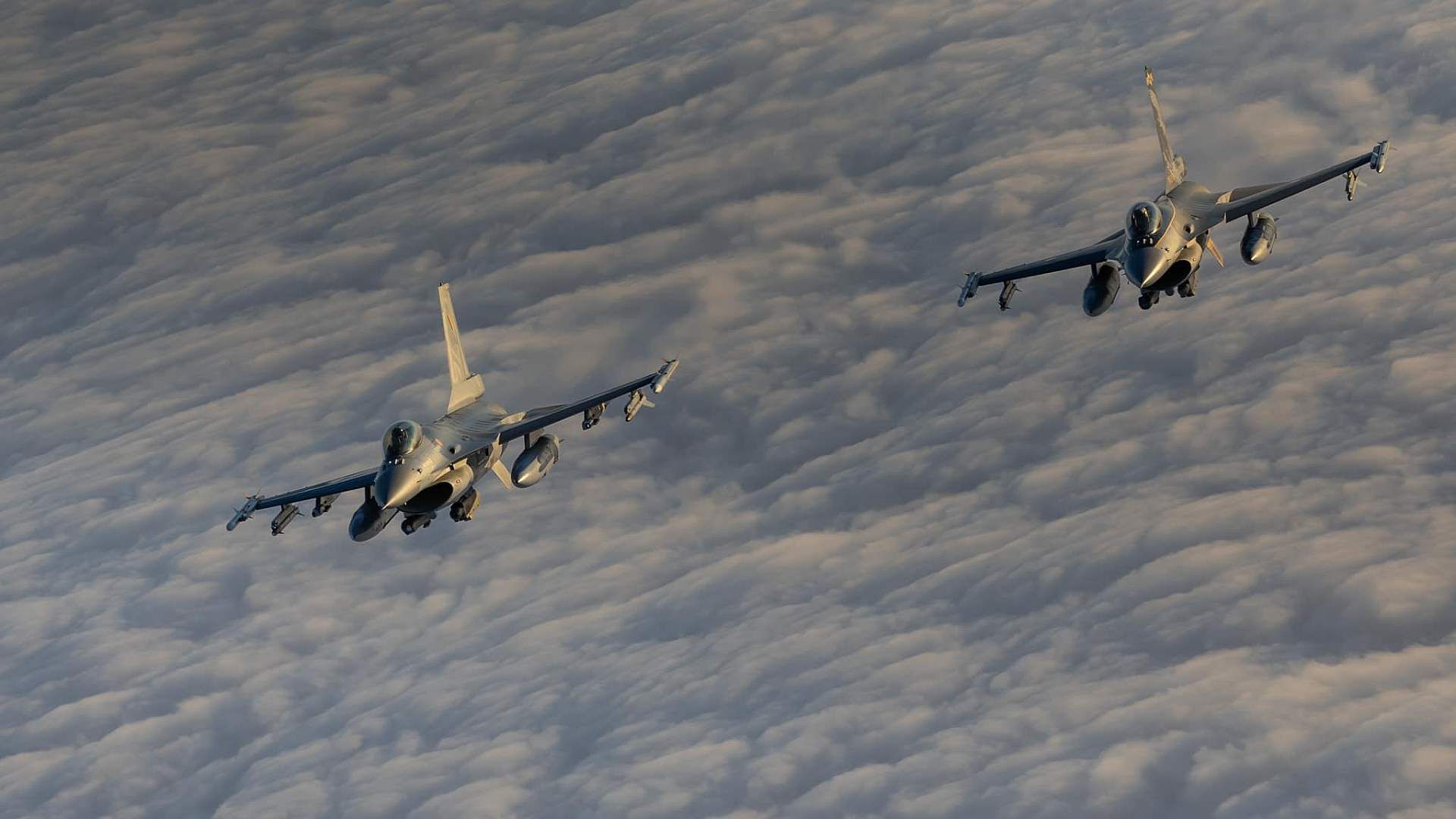

Post a reply
- Go to Previous topic
- Go to Next topic
- Go to Welcome
- Go to Introduce Yourself
- Go to General Discussion
- Go to Screenshots, Images and Videos
- Go to Off topic
- Go to Works in Progress
- Go to Skinning Tips / Tutorials
- Go to Skin Requests
- Go to IJAAF Library
- Go to Luftwaffe Library
- Go to RAF Library
- Go to USAAF / USN Library
- Go to Misc Library
- Go to The Ops Room
- Go to Made in Germany
- Go to Campaigns and Missions
- Go to Works in Progress
- Go to Juri's Air-Raid Shelter
- Go to Campaigns and Missions
- Go to Works in Progress
- Go to Skinpacks
- Go to External Projects Discussion
- Go to Books & Resources
